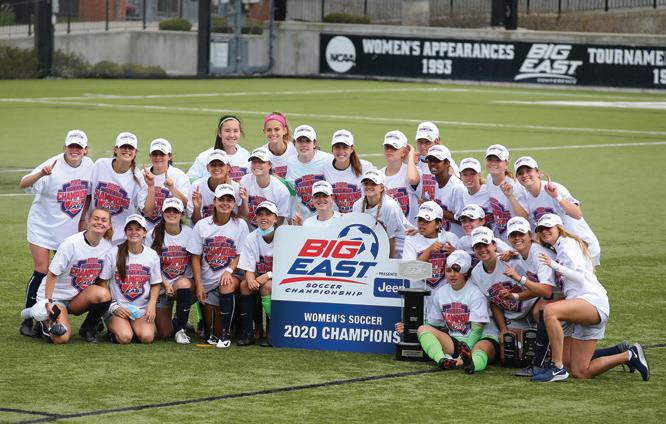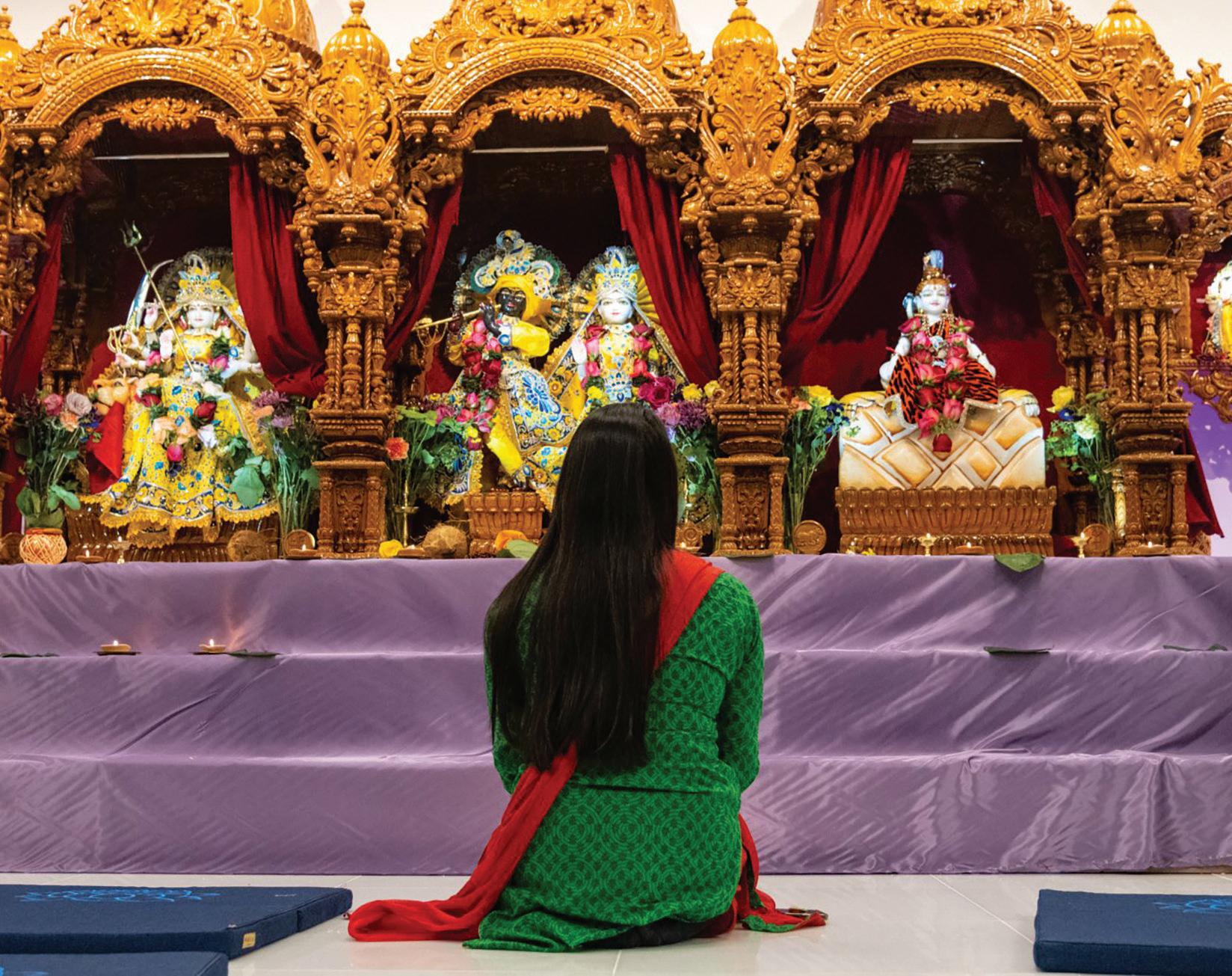
59 minute read
CAMPUS NEWS
The new Dharmālaya, housed in the Thomas and Dorothy Leavey Center, is a testament to Georgetown’s commitment to religious diversity.
Georgetown unveils new Dharmic meditation center
Georgetown’s Dharmālaya, a meditation center for students of Sikh, Jain, Buddhist, Hindu, and other Dharmic traditions, celebrated its unveiling last fall. The center offers a safe, comfortable space for varying Dharmic traditions to gather in groups, practice religious and spiritual traditions, and meditate. It is the first of its kind to be opened on a U.S. collegiate campus. Sannidhi Shashikiran (NHS’22), president of the Hindu Student Association, uses the center during the weekly Sunday Aratis held by Dharmic Life. “As someone who has been involved with the Hindu Students Association and has heard about a theoretical Dharmic prayer space since my first year, I am beyond excited that the space has come to fruition during my time at Georgetown,” Shashikiran says. “Along with other members in the Buddhist Student Association, I have used it as a meditation and social space,” says Yalin Wu (C’24). “We have weekly meditations on Thursdays led by V. Yishan and student-led meditations on Fridays. After meditation, we come together to discuss our experiences with Buddhism under themes like compassion, relationships, and inner peace.” The Hindu Student Association, Buddhist Student Association, and Sikh Student Association collaborated on the planning and use of the Dharmālaya. They wanted a communal space to practice ritual-based meditation while at Georgetown. “I cannot wait to see how the space serves as a home to students at Georgetown in the coming years,” adds Shashikiran. • —Bhriana Smith
School of Continuing Studies bolsters artificial intelligence offerings with experts from Google, Cambridge
When students asked the Georgetown School of Continuing Studies for more industry insight into how to leverage artificial intelligence, Professor Frederic Lemieux, faculty director of the master’s in applied intelligence, tapped into his network to update the Certificate in Artificial Intelligence Management. “One of the recurring demands we heard from students was to establish better connections with AI industry leaders,” Lemieux says. “So we revised the curriculum to involve and engage more with those giants in AI that are innovating the field,” from business leaders to ethicists. Through the revamped certificate program, professionals can learn directly from AI experts at Amazon, Google, Accenture, Hewlett Packard, and the University of Cambridge about how AI provides solutions for challenges related to processing massive amounts of data, finding patterns, and producing insights. Now in its third year, the program attracts working professionals from government, business, and defense sectors. Over three days, students develop a business case for installing an AI solution to an institutional program, present their cases to a panel of industry experts for feedback, and make revisions before showing it to their organization. One student working in pavement infrastructure proposed that their organization deploy surveillance drones to capture the texture of asphalt on roads and bridges. In this way, they could better plan which sections of the U.S. transportation infrastructure would need repairs first. Another student addressed the problem of their company losing profit due to a slow response when items were claimed missing. They proposed using an AI system to process claims, identify shipments, and track, retrieve, or reship items faster. Professionals also took the class to improve their arguments for project proposals. An AI lead at the U.S. Postal Service took the course to mount a justification to modernize the agency’s AI to better read addresses on letters and packages. Two professionals in the Department of Defense took the class: one to convince leadership to use AI to improve intelligence sharing among the branches of the military, and another to gain support for leveraging AI into more complex and realistic cybersecurity training.
Students also survey the laws governing AI with experts from Wiley Law, ponder moral dilemmas in AI with an ethicist from the University of Cambridge, and explore how AI integrates with cloud technology with a technologist at Microsoft. Finally, the program emphasizes the areas in which AI is no substitute for human judgment. For example, an AI program cannot reduce the bias in organizational hiring if it is trained using biased data; accountability lies with HR professionals to train hiring managers to recognize and address implicit biases. “It’s an important challenge to make the use of AI more respectful of humanity and more transparent,” Lemieux says. “That’s why we are tackling the most pressing issues related to ethical AI.” •
—Kate Colwell
The power of history
Q&A with Pulitzer Prize-winner Marcia Chatelain, on her career at Georgetown, her research, and what it means to be a Hoya
Marcia Chatelain, professor of History and African American Studies, received Georgetown’s 2022 Distinguished Leader Award. In 2021, she was awarded the Pulitzer Prize in History for her book Franchise: The Golden Arches in Black America.
What drew you to teach at Georgetown University? When I came to Georgetown, I was yearning for a place that could support my research. I wanted a place that not only had the intellectual contributions of faculty, but a place that truly believed in making those contributions, not just in the academic space but in the public space and in a broader context.
How did you become interested in history and in food as a reflection of racial inequality? I’ve always had a general interest in storytelling and a deep interest in history. I enjoy studying the context in which people emerge and the ways that history can be an active tool for social change. In the early 2000s, I was introduced to many food justice projects at Brown University, while I was earning my doctorate. I started to learn from people who were grappling with this issue. I saw that many had policy solutions and other ideas, but they never seemed to use history as a way to understand the conditions in which people were forced to make decisions about what to eat.
What could be a viable solution to the problems of food selection within lower socioeconomic communities? We have to understand that the way we eat is a direct result of the way we live our lives. Having an economic disadvantage puts so much pressure on every decision. Why don’t we start with the end of starvation wages? Why don’t we have an eight-hour workday, high-quality public housing, access to health care, good schools, free college, and free child care? Typically, when I ask these questions, people will respond “Well, you didn’t talk about food,” but these are all of the things you really need to have in order for food to be a conscientious choice. You won’t have the ability to follow the diet your doctor wants you to follow, or to exercise as much as you’re supposed to, if you’re living in this highly stressful environment where your economic viability is always in question. The more resources that everyone has access to, the more thoughtful decisions people can make about what they eat.
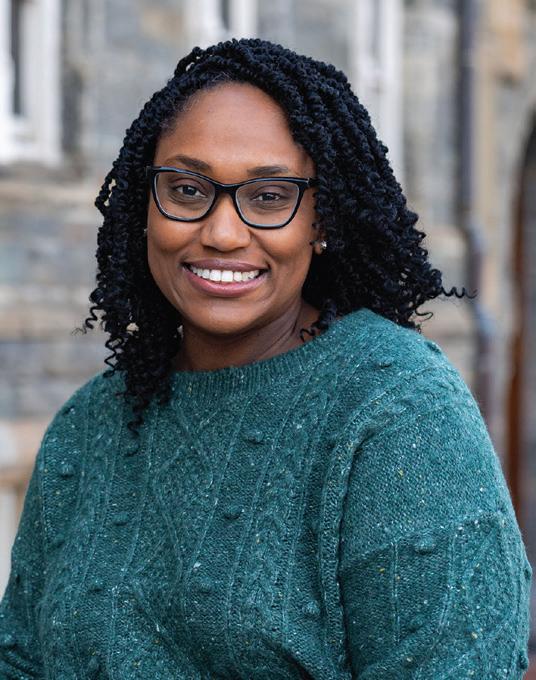
What would you like to see Georgetown do to further highlight racial injustices and promote inclusivity within the university? Georgetown has made some bold and important steps around the issue of the university’s history and slaveholding. Considering that it has been seven years since that work was initiated, I think it’s time to evaluate some of those plans and to implement a university-wide course for all students to help them understand what it means to be a Georgetown student. What does it mean for us today to benefit from this incredible and heartbreaking human sacrifice? How does that inspire us to learn from and relate to each other in a more thoughtful way? • —Bhriana Smith
POMP AND CIRCUMSTANCE
Government, finance, and international politics were the top three majors for last year’s graduating class.
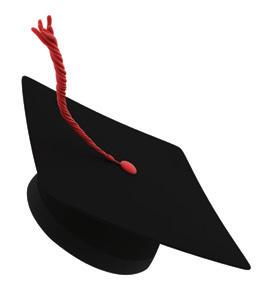
In Spring 2022, Georgetown’s Prisons and Justice Initiative launched its inaugural bachelor’s degree program for incarcerated students, a one-of-a-kind program at a four-year university. The degree-granting undergraduate program in liberal arts builds on the initiative’s success in bringing credit-bearing courses to incarcerated students at the D.C. Jail through the Prison Scholars Program. “We’re responding to a crisis that has locked an unprecedented number of our fellow citizens behind bars when they are needed in our communities,” says Joshua Miller, who serves as assistant teaching professor in the Department of Philosophy, director of education for the Prisons and Justice Initiative, and managing director for the Georgetown Pivot Program. Three hundred incarcerated individuals in the Maryland state prison system applied for the B.A. in liberal arts program, and 25 were selected for the first cohort through writing samples and interviews. All admitted students convene at Patuxent Institution in Jessup, Maryland, where they started the semester in COVID-19 quarantine, submitting reflections on the nature of authority and the abuse of power via paper letters to Miller, who teaches Philosophy and Intellectual History. “They are deeply engaged with the material, and they’re finding all these connections between texts,” says Miller, as he was teaching The Tale of the Eloquent Peasant from ancient Egypt and Euthyphro from ancient Greece. “They’re doing close line-by-line analysis and finding contradictions. Any professor in the country would say, ‘that’s a fantastic class.’” Miller’s course and Life Writing are the first two offered in the cohort model, which will expand course choices as more students join the program. Students take two four-credit, intensive courses per semester, totaling at least 30 courses in about five years. The core curriculum closely mirrors those of main campus undergraduate programs in the College, but with more intensive writing and foreign language requirements. The initiative drew from theology, philosophy, history, and political theory to form new disciplines: students can major in cultural humanities, global intellectual history, or interdisciplinary social science. When COVID-19 conditions improved, Miller began holding class in person. “The experience has been electric,” he says. “The students throw themselves into the work in a fantastic way that mixes joy and duty. They have this servant-leadership quality, making sure others are heard and thinking about what would be good for the cohort.” Miller sees the cohort creating a network and feels their palpable sense of responsibility to all incarcerated individuals in Maryland. He believes that future advocates are among his students.
“The people that we work with inside of prisons are talented, capable, promising human beings,” Miller says. “They are future leaders of the civil rights struggle to end mass incarceration, and they will be solving systemic problems of injustice for decades to come.” •
Joshua Miller (left), director of education for the Prisons and Justice Initiative and managing director for the Georgetown Pivot Program, and Marc Howard (right), director of the Prisons and Justice Initiative, celebrate Georgetown Prison Scholar Jean Remarque, who received a certificate for completing the the Fall 2021 semester at the D.C. Jail.
—Kate Colwell
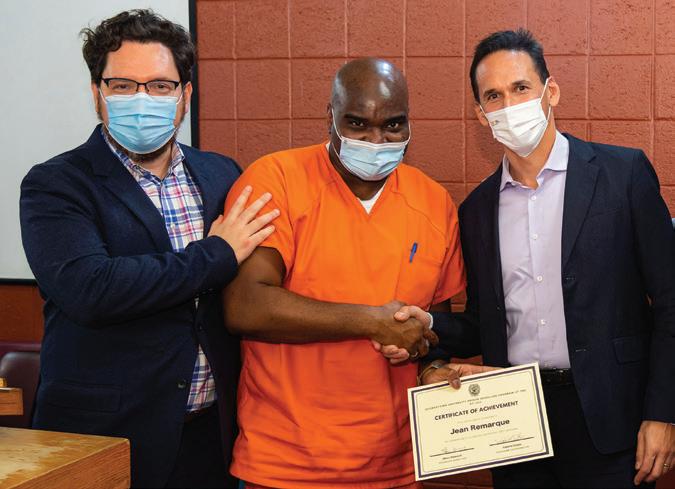
MORNING FUEL
The most-sold specialty drink at Georgetown’s Grounded café last semester was an iced vanilla caramel latte called U.G. Love. Almost a quarter of them used oat milk.
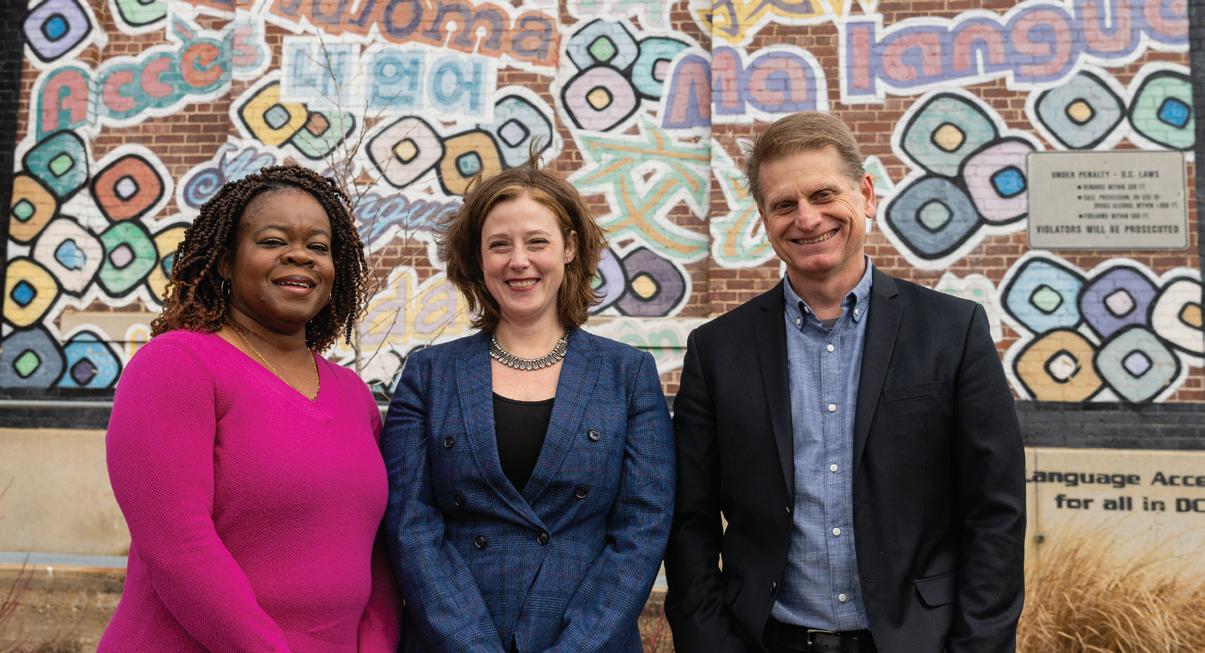
Professors Sabrina Wesley-Nero (SFS’95), Crissa Stephens, and Douglas Reed, the principal investigators of Project ELEECT, stand before the “Language Access for All in D.C.” mural created by Criomatic Muralist Juan Pineda in partnership with D.C.’s Office of Latino Affairs.
Project ELEECT advances educational justice in D.C.
Three Georgetown faculty members have initiated a five-year project, supported by a $2.6 million grant from the Department of Education, to improve educational equity for multilingual K through 12 students in Washington, D.C. Grounded in antiracist work, the English Learners’ Educational Excellence Capitol Teacher Training Project (Project ELEECT) seeks to improve outcomes for teachers, students, and entire communities. Led by Douglas Reed, Sabrina Wesley-Nero (SFS’95), and Crissa Stephens, Project ELEECT uses a two-pronged approach to teacher training. First, it identifies and recruits multilingual aspiring teachers and—when combined with Georgetown aid— covers at least 70% of the tuition costs to attend Georgetown’s Educational Transformation master’s program with a learning and teaching concentration. Second, it provides credentialed D.C. teachers of any subject matter with 80% of the cost of professional training to better meet the needs of students whose first language is not English. The project aims to train more than 130 teachers, partnering with District of Columbia Public Schools and more than 20 charter schools.
Project ELEECT improves the quality of teaching and also helps equip teachers to advocate for equitable, culturally inclusive school policies. “Schools need support to best meet students’ linguistic and civil rights,” says Stephens, an assistant teaching professor in Georgetown’s Master’s in Educational Transformation. “Our teachers will be trained with an equity lens and deep knowledge of how to support language development in education, so when they see ways that their school could better reflect the identities of all of its students, they’re able to use that lens as policy actors and have a voice in changes that may need to happen.” D.C.’s population is linguistically diverse, with many students speaking Spanish, Amharic, and other languages at home. Teachers can better form relationships with students and help them thrive by respecting the linguistic assets of multilingual learners and positioning linguistic diversity as a benefit. “It’s a tremendous asset within the K through 12 student body to have students who have such an enormous array of linguistic talents,” says Reed, professor of government and director of the Educational Transformation master’s program. “That makes it easier to bridge into English and also deepens their learning in other areas as well.”
Although the Educational Transformation master’s program marks the university’s first foray into U.S. teacher certification, Georgetown has been involved in educational justice for 25 years. “For me, educational justice is central to the identity of Georgetown University,” says Wesley-Nero, director of the undergraduate program in Education, Inquiry, and Justice, co-creator of the graduate program in Educational Transformation, and faculty lead of the Learning and Teaching concentration. “When we see educational opportunities denied, we see the outcomes in health care, in our economy, in our political activity, and in our communities. To be a place that values cura personalis, we need education that nurtures the entire person. For multilingual students, that means their entire linguistic repertoire.” • —Kate Colwell
The academic field of disability studies took root at Georgetown in 2014 with a cluster of classes in theology, literature, and theater. From that small seed the program has grown and flourished, branching into a series of interdisciplinary collaborations across the university. In addition to the minor in Disability Studies, offerings include a new M.A./Ph.D. certificate, the Artist/Scholar/Activist in residence, student fellowships, and a Disability Empowerment Endowed Fund.
Founded by Libbie Rifkin and directed by Jennifer Natalya Fink, the program both supports the estimated 14% of Georgetown students who identify as having a disability and seeks to change the way the community thinks about disabilities.
“A disability is a dimension of human diversity, not a deficit,” explains Fink. “Learning about disability is an important component of cura personalis, or care of the whole person. Everyone can benefit from thinking about their bodies and minds—their capacities, functions, and differences. That will make Georgetown an even more inclusive institution.”
Grounded in the humanities and fueled by student interest, the courses explore such issues as ecojustice, epidemiology, the refugee crisis, health inequities, moral leadership, and genomics through this unique lens. “Our work can’t exist in a silo,” says Rifkin. “We want the program to be a breeding ground for a cultural transformation. That’s why the extracurricular component is essential. Here in Washington, D.C., there are so many opportunities to engage in research, practice, art making, and activism.” Here on the Hilltop, the students have the opportunity to learn from and contribute to the work of renowned choreographer/ dancer/playwright/activist Jerron Herman as he prepares his latest work, VITRUVIAN, for its May 2022 premiere in New York City. “I’d like to bring academics and practice together for the Georgetown students by giving them a window into the collaborative process of artistry,” explains Herman, an ambassador for the Cerebral Palsy Foundation and trustee for Dance/USA. “Access to artists is rare. The team for VITRUVIAN includes disabled people of color who are exploring, among other things, stuttering, the concept of blackness, and trans rights. It’s a contemporary disability arts microcosm. Students will be able to experience that familial energy along with us.” In addition to open rehearsals, Herman offers virtual office hours, class visits, and public workshops on the artistic process. The residency was made possible by a gift from Matt (C’02, L’09) and Jenae (L’09) Ruesch. The couple also funded the creation of a three-week disabilities studies module for the Introduction to Ethics course offered through Georgetown’s philosophy department. Ethics Lab Director Maggie Little hopes the module will be incorporated more broadly across the university. • —Camille Scarborough
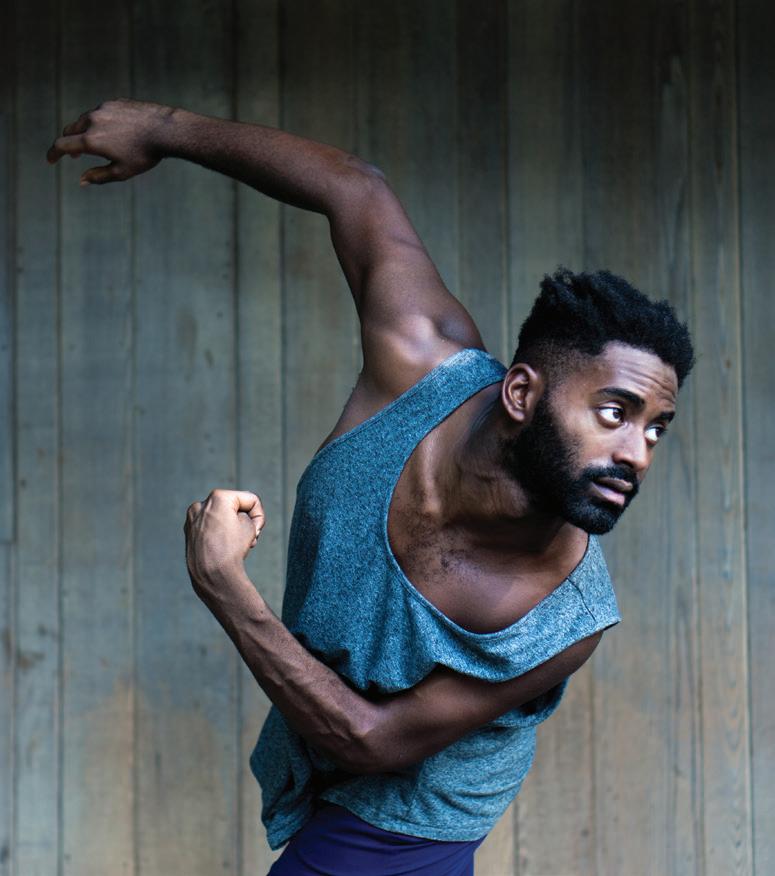
Photo courtesy of Marlboro College
Jerron Herman teaches movement from one of his solos in front of dance majors.
Where credit connects with cura personalis
Would it surprise you to know that Georgetown hosts a banking and financial services institution that is federally recognized and guaranteed by the National Credit Union Administration? And that this institution, which services more than 750 loans offered at below market rates, just capped off its most successful year ever with a $5.5 million loan portfolio and $20 million in peak assets, and is presided over by an undergraduate government major with no prior finance or business experience? Dylan Rothschild (C’22), chairman of the board and chief lending officer of the Georgetown University Alumni and Student Financial Credit Union (GUASFCU), maintains he is not unique. “We recruit from all corners of campus—not just business and finance. Our interns go on to careers in medicine, teaching, government, technology, and the nonprofit sector, as well as the Peace Corps and AmeriCorps.” After graduation, he will be starting his own career at Google, working to help the company hone its user privacy policy and fight fraud and abuse. GUASFCU is staffed and operated entirely by undergraduate students, who start out as tellers and advance into roles in marketing, bookkeeping, underwriting, and management, while learning the nuances of financial literacy. Rothschild credits the experience “1000 percent” for giving him a leg up in marketing himself for the career he wanted. “We get hands-on experience honing our communication and cooperation skills, managing peers, and understanding what makes a good leader.” Grounded in Jesuit values like cura personalis, GUASFCU views loan applications in a holistic way, in hopes of providing access to people who might be turned down by other financial institutions. Most students have little or no credit experience, and what they have may not be the best. “We understand that a lot of people have had financial difficulties in the past. We work with them when another institution might just say ‘no,’” Rothschild says. “We know our community members are doing their best to move into a financially responsible situation, and we want to be that bridge for them.” In addition to offering budgeting and credit workshops, GUASFCU promotes financial literacy through a unique product called the Credit Builder, issuing a secured loan to any student, alumnus/a, or family member, which is then paid off in their name in order to establish or boost their credit history. Members who have opened Credit Builders with no prior credit history have seen scores rise to the 700s. That can make a profound difference in their ability to rent an apartment or even get a job. GUASFCU also makes auto and unsecured loans, provides free access to 55,000 ATMS, and even issues rewards program debit cards offering discounts at local businesses. “As a nonprofit business, our utmost goal is to make an impact on the financial lives of all members of the Georgetown community,” says Rothschild. “We are people with a lot of different passions, united by a shared passion for the Georgetown community. At the end of the day, that’s what drives our mission.” •
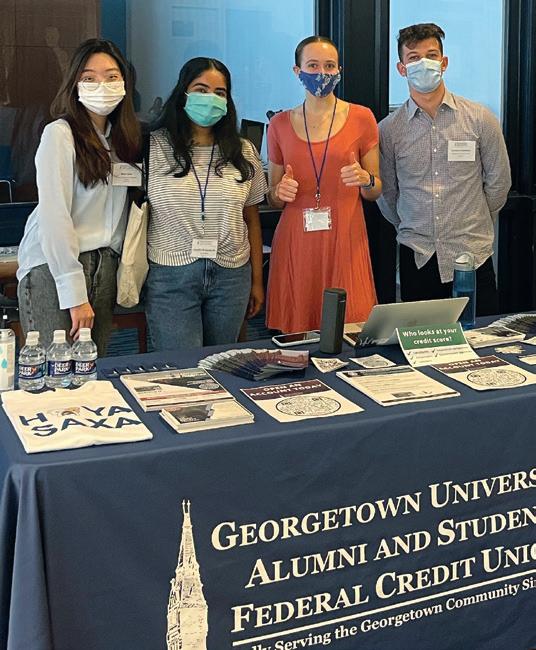
At tabling events on campus, GUASFCU members describe services and benefits to students.
—Patti North

A PERFECT MATCH
The Corp once ran a campus date matching service each winter. Students filled out compatibility questionnaires, and members of The Corp matched people up before Valentine’s Day.
Georgetown launches new Earth Commons Institute with big goals for the planet and the Hilltop
BY JANE VARNER MALHOTRA | DESIGN BY SHIKHA SAVDAS
Georgetown currently sources two-thirds of its electricity from a renewable energy power purchase agreement, and aspires to become carbon neutral by 2030 and achieve 100% renewable power by 2035, in addition to its ongoing commitment to divest from fossil fuels, which began in 2020.
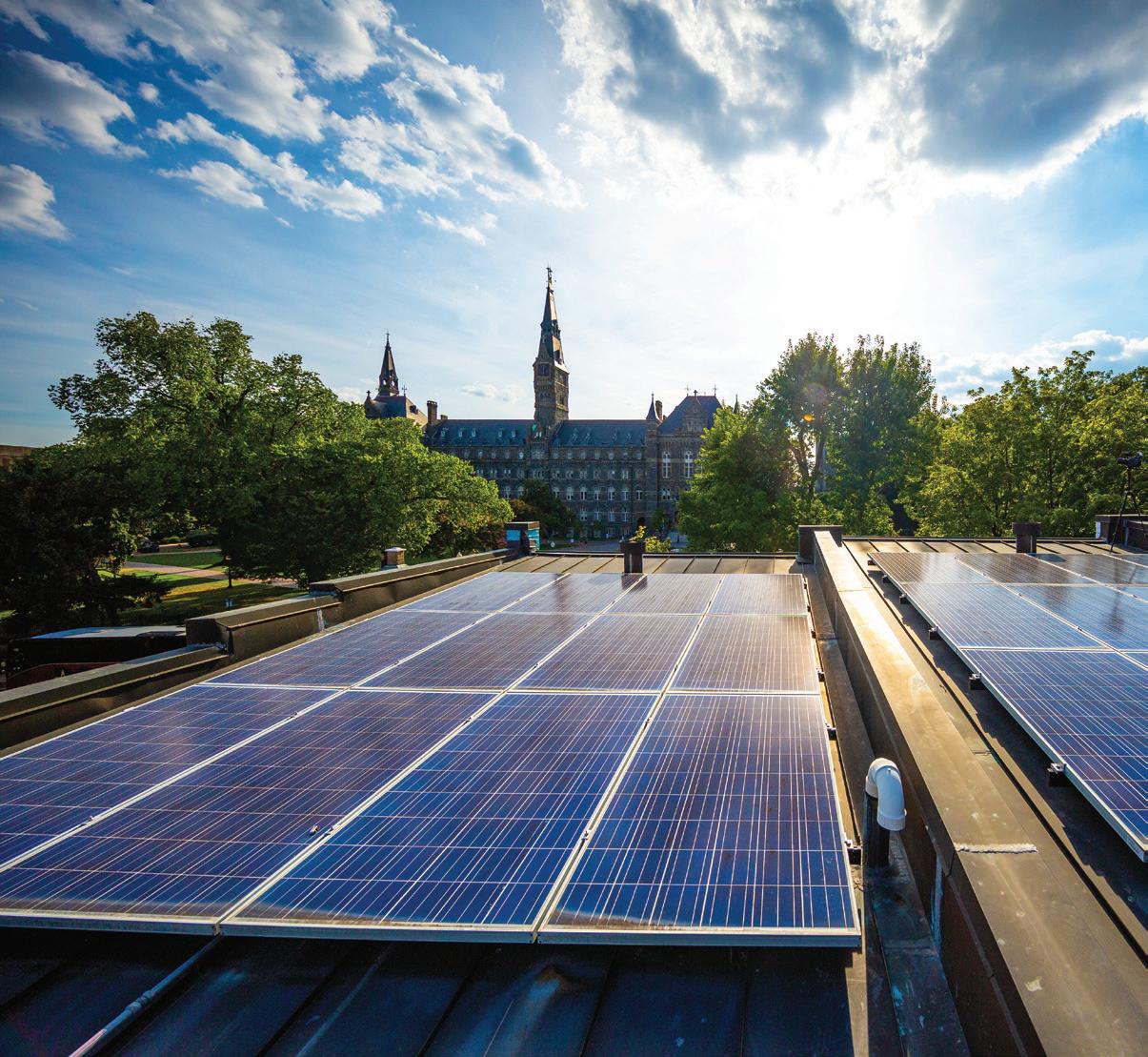
In February, Georgetown announced the launch of an ambitious new interdisciplinary institute for study, research, and action around care for our common home. The Earth Commons, the university’s institute for environment and sustainability, will have innovative graduate degree programs and undergraduate offerings spanning the disciplines and schools. The institute will also elevate impact-focused research at Georgetown, and forge new partnerships with government and nongovernment institutions and corporations around sustainability and environmental education, research, and service.
The institute’s launch capitalizes on increasing faculty expertise across the university, as well as strong student interest in the field, and coincides with a call from Pope Francis for Catholic institutions to make care for the environment an urgent moral priority.
ON CARE FOR OUR COMMON HOME: INSPIRED BY LAUDATO SI’
Earth Commons takes its inspiration from Laudato “We need only take a frank look at the facts to Si’, the powerful 2015 encyclical by Pope Francis on see that our common home is falling into serious disrepair.” (Laudato Si’, no. 53) the pressing need to reshape our relationship with the environment. The document outlines the problem of global environmental degradation and the impact on all creation, but particularly on the poor. “With the launch of our new Earth Commons Institute, Georgetown is in an even stronger position to realize the impact that we can make to better understand and respond to urgent challenges facing our global environment,” says Georgetown President John J. DeGioia. “Providing a more sustainable planet for future generations is both a creative and inspiring ambition that requires the collaborative commitment of disciplines of every kind, focused on the larger goal of advancing the common good.” In April 2021, Georgetown announced the newest “Spirit of Georgetown” value: care for our common home. Others include contemplation in action, people for others, and faith that does justice. In a way, care for our common home weaves together each of these values with the big picture reminder that we are all connected as part of our precious and fragile planet. The Earth Commons helps make visible both Georgetown and the Catholic Church’s renewed commitment to tending to our common home. Mark Bosco, S.J., vice president of Mission & Ministry, sees it as an extension of the Jesuit way of finding God in all things. “We can find, revealed in nature, some aspect of this transcendent God who loves us into life and calls us into human agency, calls us to work for the common good and be people for others, to nurture the environment,” says Bosco. “It is absolutely part of the Ignatian ethos. It’s no accident that as a Jesuit, Pope Francis sees this through the eyes of his Ignatian heritage.”
BUILDING ON CURRENT STRENGTH
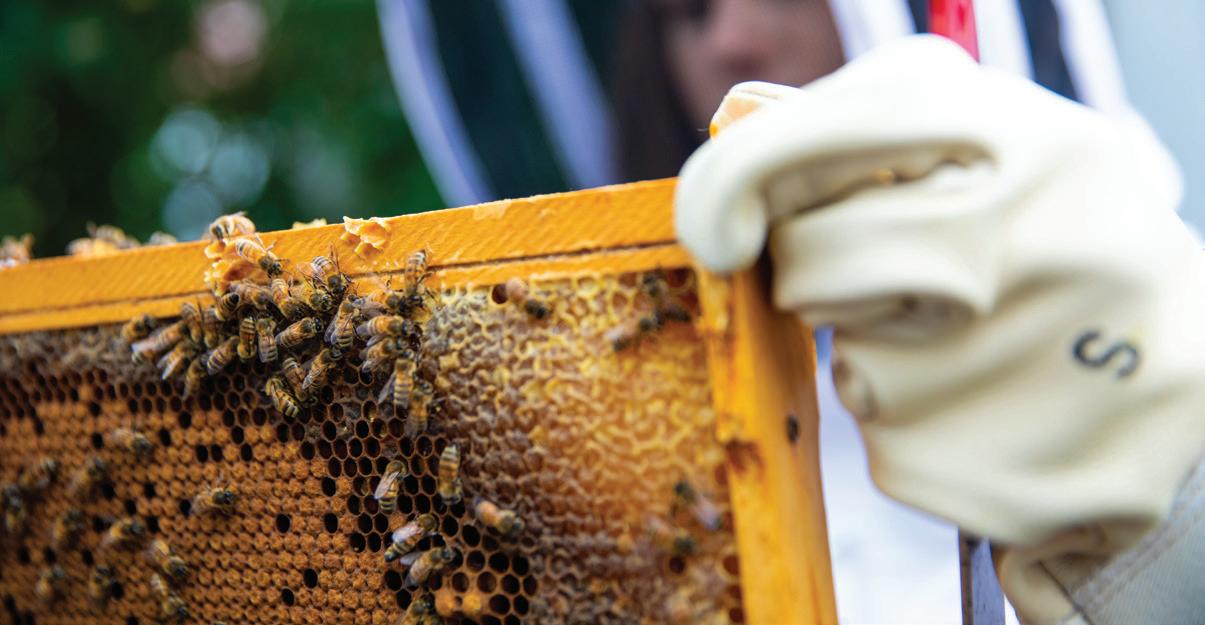
“Everything is connected. Concern for the environment thus needs to be joined to a sincere love for our fellow human beings and an unwavering commitment to resolving the problems of society.” (Laudato Si’, no. 91)
Care for the environment is a long-standing commitment at Georgetown. The university launched the Center for the Environment in 1996, and the Georgetown Environment Initiative (GEI) in 2012. There has continued to be a strong institutional commitment through the Office of Sustainability and ambitious university goals and achievements around renewable energy, energy efficiency, and carbon neutrality. The university has also made important progress in green building, creating a more circular economy, and investing in sustainability through the endowment. The new Earth Commons Institute builds on and expands these strengths. Led by renowned bird ecologist Peter Marra, Laudato Si’ Professor of Biology and the Environment, the institute is partnering with a wide range of environment and sustainability faculty across the nine schools, along with the Office of Sustainability. Marra estimates that there are currently over 70 faculty members actively involved in research and education around the topic. Now is the time to harness these resources and create a critical mass to have an impact, he says. “The Earth Commons is intentionally ambitious because we have this massive environmental issue—the most important thing we are dealing with as human beings on the planet,” says Marra. “If we don’t deal with our environmental problems, nothing else matters.” The institute is expansive in its vision because environmental problems won’t be solved by any one knowledge domain, says Provost Robert Groves. “The Earth Commons is energizing all of these pieces into a whole to increase the impact at Georgetown,” he notes. Law and policy are critical partners, he adds, as well as the sciences, naturally. In fact, the Earth Commons’ first degree program is a joint master’s degree between the Earth Commons (Graduate School of Arts and Sciences) and the McDonough School of Business. “Combining the environment and business isn’t something most people think of as natural dance partners but they are in so many ways,” Marra says. The Master of Science in Environment and Sustainability Management is a one-year program and includes courses from climate change economics to impact investing, all with the Georgetown values focus on ethics and justice. Interdisciplinarity is key to the Earth Commons vision: “to catalyze solutions to the world’s most urgent environmental and sustainability challenges as an internationally recognized institute for innovative education, groundbreaking research, and transformative action—on Georgetown’s campus, in our community, and around the globe.” In Laudato Si’, Pope Francis underscores the importance of a necessary deep cultural shift in how people treat the planet. Changing culture around the environment requires partnership not only with the sciences, policy, law, business, and health, but the arts and humanities, as well. The Earth Commons works with the Humanities Initiative and the Laboratory for Global Performance and Politics, among others, to create the Voices of the Environment. The annual celebration of various aspects of the environment and sustainability grew out of the GEI’s Earth Week events in April. This year’s focus is on intergenerational justice, with a special emphasis on indigenous perspectives.
“We can no longer speak of sustainable development apart from intergenerational solidarity.” (Laudato Si’, no. 159)
Today’s generation of Georgetown students shoulders a heavy concern for the environment. It can be hard to envision a healthy future for oneself, let alone one’s children and grandchildren, considering the trajectory humanity is currently on. “A lot of our generation feels like this is the existential threat of our time,” says senior Shelby Gresch (SFS’22) of Seattle, Washington. Gresch is an active member of Georgetown Renewable Energy and Environmental Network (GREEN) and a student in the School of Foreign Service’s Science, Technology and International Affairs program, minoring in Spanish with a major concentration in energy and the environment.
She has dedicated much of her time at Georgetown to the environment, winning a Laudato Si’ Grant from the Georgetown Environment Initiative (GEI) to design a first-year orientation course on how to live sustainably on campus. As part of her current internship with the GEI, she is helping plan a student-run farm on campus. Happy to see environmental study expand into the much larger, interconnected, interdisciplinary Earth Commons, she says she’s glad that incoming students will have the opportunity to take advantage of the new offerings. “The institute will focus on different ‘commons’ or specialty areas like food and water, biodiversity, and sustainability,” she says. “Embedding it across all of Georgetown’s campuses is critical because thinking about the environment should be at the top of our consciousness.”

Students like Gresch and senior Rachel Kirichu (SFS’22) of Detroit, Michigan, have dedicated countless hours through student groups like GREEN, internships with GEI and the Office of Sustainability, and informal volunteering to help grow the environmental movement on the Hilltop and beyond. But the good news is they weren’t starting from scratch, says Kirichu. “I’m thankful that I came into Georgetown with an already established Office of Sustainability and student groups that I can be involved with in environment and sustainability. I didn’t have to establish these—previous students, faculty, and staff laid the groundwork that I can build up from. So I’m very thankful for that—it gave me the space to cultivate my passion. I hope to provide the same for new students to come in and do the same, to create even more effective change in our community and beyond.” Gresch notes that the sense of urgency drives their generation to prioritize the environment, but there’s a sadness around it too, because other interests might get overshadowed by it. “There feels like a loss of choice or opportunity. If I didn’t feel like we all needed to be working on this I wonder if I’d be doing something else. I love the environment and I love what I do but there’s an urgency to this that demands our attention and makes it hard to choose to do something else like be a dancer or something. There are a lot of things we can do to make the world a better place, but we have to do this immediately.”
Photo: Tim Romano courtesy of Smithsonian
“The Earth Commons approach is immersive and experiential,” says Professor Peter Marra, “enriching the lives of students through hands-on learning that emphasizes the interconnectedness of life and actions needed to be better stewards of our common home.”
The Earth Commons’ first degree offering is a one-year joint master’s program with McDonough School of Business, including courses from climate change economics to impact investing, with a focus on ethics and justice.
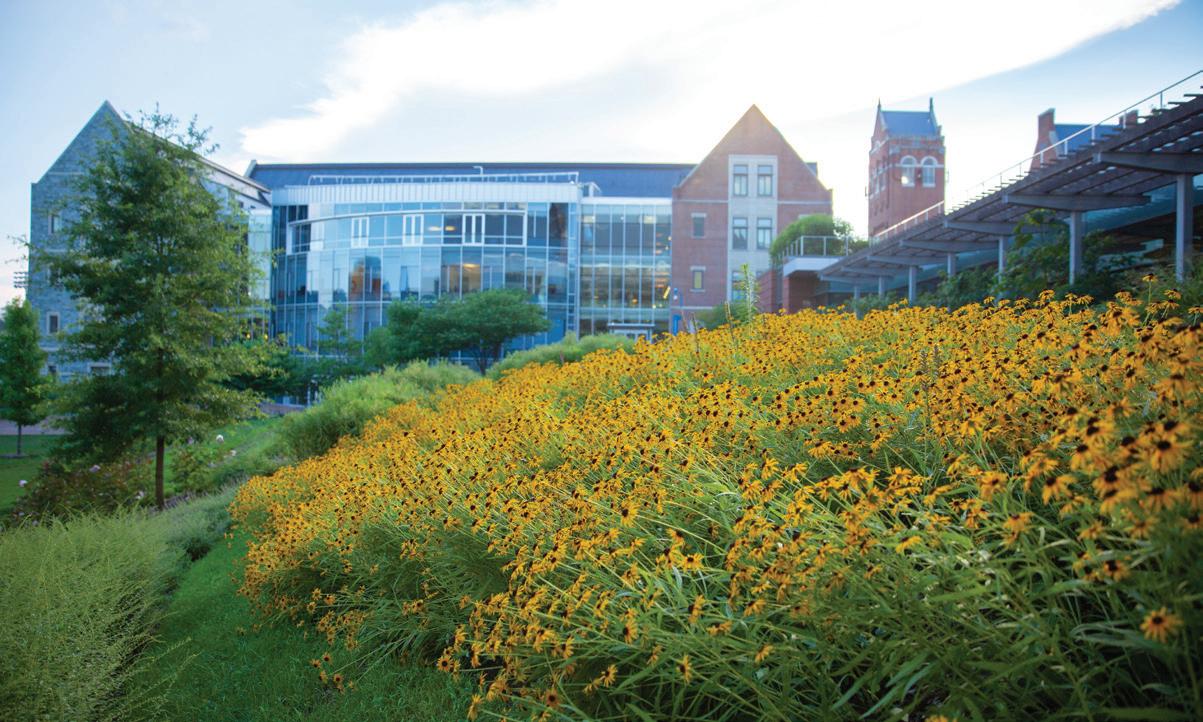
EMPHASIS ON TEACHING, JUSTICE
“It is essential to show special care for indigenous communities and their cultural traditions…. For them, land is not a commodity but rather a gift from God and from their ancestors who rest there, a sacred space with which they need to interact if they are to maintain their identity and values.” (Laudato Si’, no. 146)
As a Jesuit university with a strong tradition of teaching excellence, academics are the focal point of the Earth Commons Institute. “We are leading with education,” Marra says. In addition to the joint master’s degree, the Institute hopes to develop a novel undergraduate bachelor of science degree for Fall 2023. “It will be experiential, interdisciplinary problem solving, and international, we hope, with a global component each of the four years students are here.”
Hiring more faculty is also part of the plan, including climate scientists, geographers, and experts in the social sciences looking at how humans make decisions in interaction with the environment.
“We are in such a challenging time right now with respect to where humans sit in our place with the environment. It provides me hope when I think about one of the most effective ways for us to save humanity, to save biodiversity, is to cultivate minds. To put out the next group of environmental champions,” says Marra. Georgetown’s emphasis on caring for those on the margins makes the university a natural place for a program that emphasizes environmental justice. “When looking at what populations are most harmed by environmental damage, it’s disproportionately the poor and disadvantaged,” notes Provost Groves. “Laudato Si’ provided an ethical framework to this, and we have urgent moral obligations to act on this as a university.” Kirichu wants to help expand inclusivity in the environmental movement. It’s another aspect of the effort that resonates deeply with younger activists, who have grown up with climate change as part of daily conversation. “We Z-ers need to make big changes because when we hit those benchmark years—2030, 2050—our adulthood will be greatly affected by what we decide today,” Kirichu says, noting the draw her generation feels toward this issue. “Not only because our lives are being directly affected but also to make sure the movement is more inclusive, considering Native voices, Black and brown voices, considering how climate change will disproportionately affect us. Our generation wants to make concrete change that is also inclusive and effective not just for one community or group. We want a movement that elevates different voices.”
PUTTING IT INTO PRACTICE
“Put simply, it is a matter of redefining our notion of progress.” (Laudato Si’, no. 194)
As a key partner in the work of the Earth Commons Institute, Georgetown’s Office of Sustainability is expanding its reach. Led by Vice President of Sustainability Meghan Chapple, who arrived at Georgetown in 2021, the department is taking the U.N. Sustainable Development Goals and the Laudato Si’ goals and combining them into a workable but bold approach for a university. Georgetown currently sources two-thirds of its electricity from a renewable energy power purchase agreement, and aspires to become carbon neutral by 2030 and achieve 100% renewable power by 2035, in addition to its ongoing commitment to divest from fossil fuels, which began in 2020. Chapple, who has master’s degrees in environmental studies and in business from the University of Michigan, is helping design the future sustainability priorities for Georgetown. “What will the world—and the campus—look like in 30 years and how do we shape our culture and mindset and buildings to prepare for that?” she asks. The answer to this question will take the form of “a sustainability strategy for the university that everyone has input into—faculty, students, staff, alumni, experts beyond the university who know how high we should be reaching,” Chapple says. “We’re looking at how we address our climate impact, how we become more a part of a circular, regenerative economy, and how we do this in a way that is inclusive of diverse voices. Our decisions are made with the mindset of equity and justice, so that we know how our decisions are impacting communities on campus and beyond.” The Office of Sustainability plans to continue student internships directly connected to the Earth Commons curriculum, which offer research opportunities for faculty and students. The plans for joint programming and educational efforts are still evolving. Regardless of how exactly the programs will work together, their goals are naturally intertwined, says Chapple, who adds that Georgetown is uniquely positioned to make the Earth Commons a success.
“The power of the Georgetown name— the positive emotion it stirs in people— is remarkable,” she notes. “When you combine that with the academic accomplishments that the faculty have in their research and teaching and the students have in the education they receive, along with the reach the university has in the nation’s capital and the Catholic Church, there’s so much influence this university can have around sustainability and the environment.” She encourages alumni to connect through common interests in the environment, noting that the Earth Commons may offer opportunities for workshops, speaker series, and other ways for Georgetown graduates to be involved, supporting students and making an impact beyond the Hilltop. Chapple also reminds the students she works with and all people to take heart in what we can do, and not get burdened with despair. “A lot of times we feel like it’s doom and gloom: climate change is real, everyone is sensing it, feeling it, experiencing it,” she says, noting that it’s particularly acute for people living in coastal areas and regions plagued by wildfires, intense heat, and extreme weather. “That can be overwhelming, especially as we go through this pandemic which many argue is a result of habitat destruction. It’s depressing and so daunting and can feel completely intractable.” But, she notes, “what’s really important is to remember that every action counts, every word counts, and every thought counts.” Or as Pope Francis puts it, “Let us sing as we go. May our struggles and our concern for this planet never take away the joy of our hope.” (Laudato Si’, no. 244) •
Opened in 2016, Arrupe Hall is a LEED-certified sustainable residence hall featuring a green roof, water collection, indoor bike storage, and a demonstration kitchen used for nutrition education.
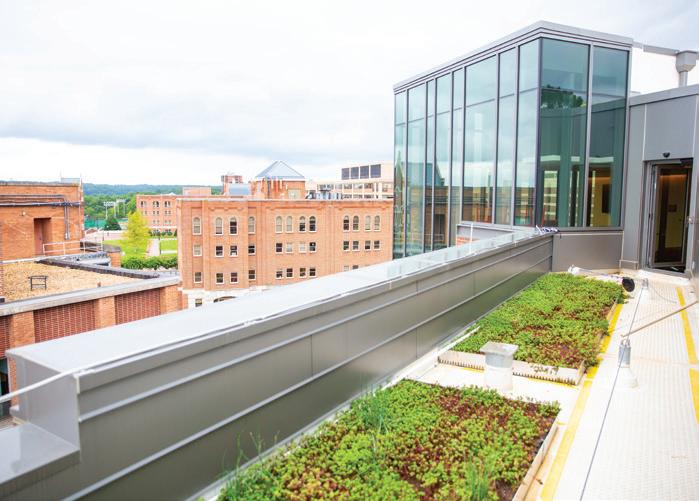
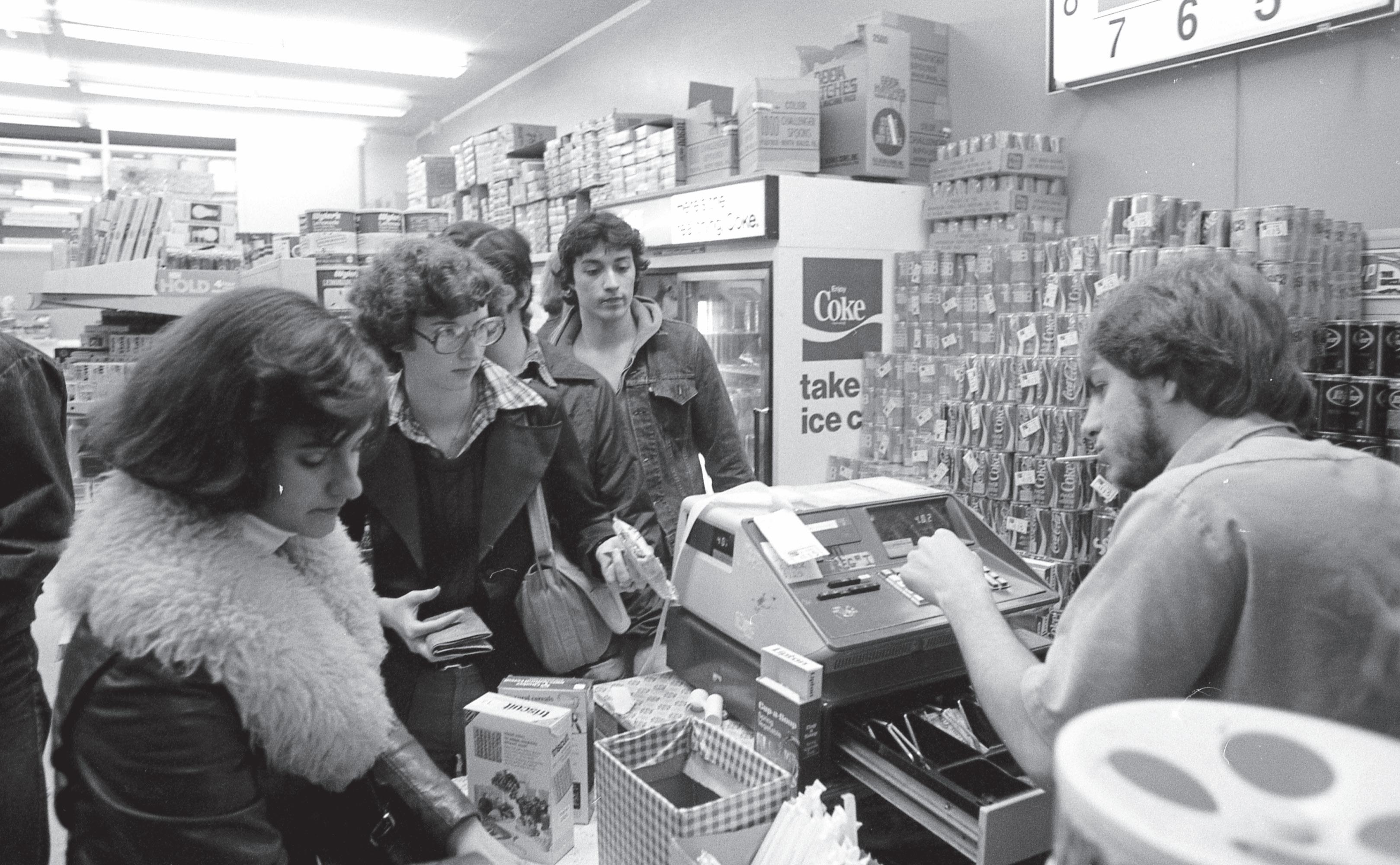

BY SARA PICCINI I DESIGN BY WANDA FELSENHARDT

2020s
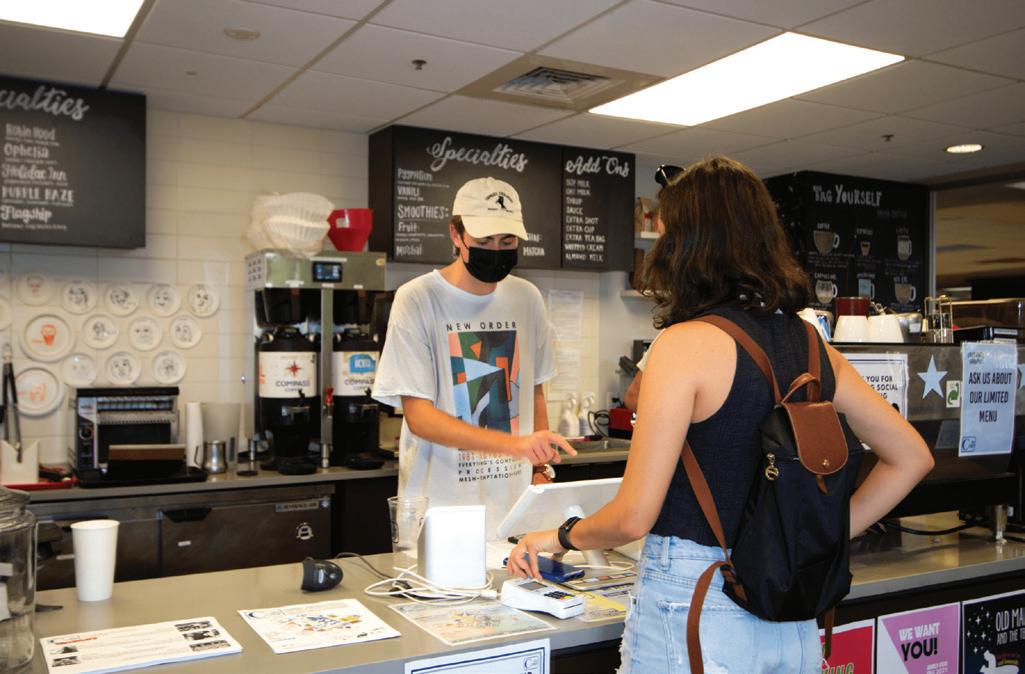

In 1973, several members of the newly established Students of Georgetown Inc.—since 1977 more commonly known as The Corp—borrowed a pickup truck, drove to a D.C. library offering free bookshelves, and transported the shelves back to campus. “A group of us, including Louise Roseman (C’76) and Deborah Lamb (NHS’76), brought them up to a room in New South, then went to a grocery store and bought a bunch of Oreo cookies and other snacks,” says Jack Leslie (SFS’76), then head of the organization. “We got a little metal lockbox, wrote ‘Vital Vittles’ on a piece of cardboard, and stuck it on the door.” Vital Vittles, still The Corp’s flagship storefront, has fueled generations of Georgetown students, whether it’s coffee for an 8 a.m. class or energy bars for a late-night study session. “I marvel at what something like Vital Vittles has become,” says Leslie. “It was very hard to imagine that our operation, with wooden shelves and a metal lockbox, would turn into the enterprise it is today.” From low-cost groceries to typing services to shuttle rides to summer storage, The Corp’s enterprises—entirely student-run—have all originated from its founding mission: “Students Serving Students.” Born out of the student activism of the late 1960s and early ’70s, The Corp brought a pragmatic approach to student advocacy. “There was a belief that to empower students, we needed to help deliver low-cost services that the university and community didn’t provide, like transportation,” Leslie says. “The demand for these services was so great, our biggest challenge was gearing up for growth,” Leslie says. “It sold itself.”
Students of Georgetown Inc., was officially incorporated as a nonprofit organization in Washington, D.C., on March 6, 1972, the result of a student government effort led by president Roger Cochetti (SFS’72) and vice president Nancy Kent (C’72). Although unique to Georgetown, The Corp was founded in the context of national events, especially controversy over the Vietnam War. “I was elected student body president in 1971 at the peak of antiwar demonstrations. It was a particularly tumultuous time,” Cochetti says. “There was a parallel consumer rights movement emerging, and an offshoot of that was the concept that students are consumers and they have rights,” Cochetti continues. Underlying all of this, he explains, was the 1971 passage of a Constitutional amendment lowering the voting age to 18. “It finalized the idea that an 18-year-old is an adult, not a child.” The precipitating event leading to the creation of Students of Georgetown Inc., was the university administration’s refusal to allow Georgetown students to house antiwar student demonstrators coming to D.C. from around the country. After consulting an attorney, Cochetti learned that Georgetown students had no ability to contravene the administration’s order.
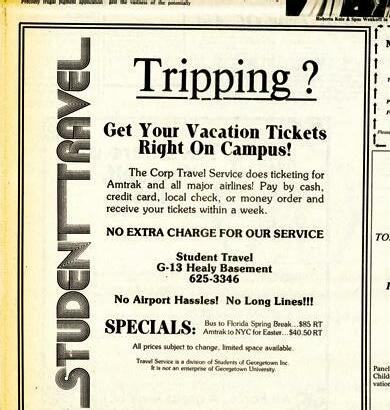
“I realized students needed some legal structure of their own to pursue what they wanted to pursue,” Cochetti says. He and fellow student government members initially considered a cooperative model like the famous Harvard Coop, but the structure was quite complicated and the student body rejected the idea. “Nancy Kent and I concluded that the most viable, most pragmatic way to pursue this idea was a nonprofit corporation,” he says. “By setting it up as a nonprofit, we presumed its orientation would be towards doing good things for students or the world, or both.” From the start, Cochetti knew the organization needed seed capital. When Kent had to step down as vice president mid-year, he recruited Mike Connolly (B’74) as a replacement. They raised $10,000 by endorsing a professional tennis tournament held on campus and collaborating with an outside vendor on a student directory. “I especially want to recognize Nancy Kent, who was there for the takeoff, and Mike Connolly who was there for the landing,” Cochetti says.
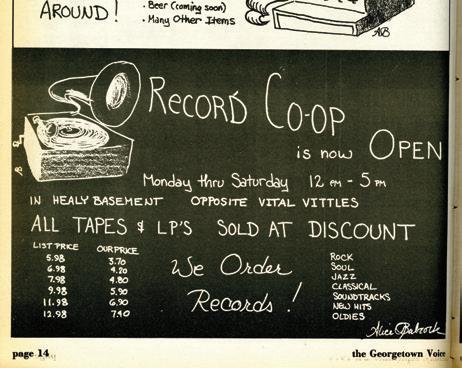
Gearing Up for Growth
At the end of his term, Cochetti turned over the reins to newly elected student government president Jack Leslie. (Under the organizational structure at the time, the student government president also served as CEO of The Corp.) “My platform was all about The Corp. In fact, I remember getting kidded about it, because my campaign poster was an organizational chart,” Leslie says. “I envisioned it as a real corporation that would run real businesses,” he says. Leslie and other members of the student government leadership team—including Bud Colligan (SFS’76), Sal Massaro (B’76) and Dave Ralston (SFS’76)—started a number of enterprises. The team created two major legacies: Vital Vittles and the shuttle service GUTS, which was later taken over by the university (see sidebar). Within 10 years, The Corp was garnering $1 million in revenue, and selling 60,000 cans of Coke a month. With coffee eventually replacing soda as the beverage of choice, The Corp opened a series of coffee shops, beginning with Uncommon Grounds in 1994. Today The Corp consists of eight storefronts and services, generating revenues of more than $5 million annually. It employs over 330 Georgetown undergraduates and funds scholarships as well
as community engagement projects. “I had no idea where it would go,” Cochetti says. “When they invited me to the 40th anniversary, I was flabbergasted to see for the first time how large and diverse The Corp had become.”
Well Grounded

The Corp’s impact on Georgetown as a whole has been multifaceted, from the early days of providing inexpensive groceries and sundries in an area of Washington that lacked low-cost alternatives, to becoming an important source of on-campus employment. “The university really feels proud of the work that The Corp does and sees them as a unique feature of student life at Georgetown,” says Erika Cohen-Derr, interim associate vice president of student affairs, who serves as a liaison to the organization. “They certainly live out the motto they’ve established, students serving students,” Cohen-Derr says. “They’re a company that pays their employees but also puts money back into the community that they’re fostering. “When we’re developing a new space on campus, they’re very proactive—they develop bold and creative ideas and they base those ideas in their own experience and the experience of their classmates,” Cohen-Derr continues. “In the case of the Healey Family Student Center, they were an essential partner.” The Healey Family Student Center, which opened in 2014, is home to the newest Corp storefront, The Hilltoss, a salad eatery that was established in response to student requests for healthier food options. Students also overwhelmingly supported an additional coffee service, so The Corp opened Grounded, a new café within The Hilltoss space. “The Corp has been one of the drivers of the campus economy,” says Bennie Smith (C’86), who started as a cashier/stocker at the former Saxa Sundries and went on to become Corp VP of Operations (COO). “The Corp has a long history of supporting students and their interests in all manner of ways, including engaging with the Georgetown University Alumni and Student Federal Credit Union. When you multiply that out over time, it results in our being a big driver of the campus economy.”
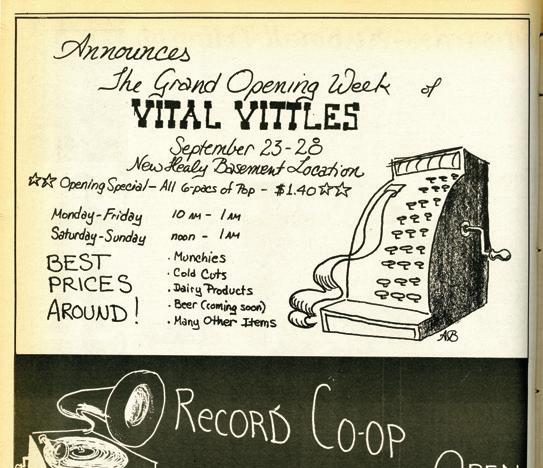
Smith notes that another key aspect of The Corp’s service mission is philanthropic support. “From its earliest days, it wasn’t just about providing low-cost goods and services,” says Smith. “The student service mission also included providing small scholarships for its employees, eventually opening that up to nonemployees.” Just as The Corp’s commercial operations have evolved to meet changing times, the organization’s philanthropic endeavors continue to evolve as well. “At the beginning of each semester, we create a general outline of how we intend to award scholarships,” says Taylor Harvey (NHS’22), current chair of The Corp Philanthropy Committee. “But while it’s important to plan, we need to recognize that student needs are constantly changing. “One year ago, everyone thought that with vaccines, COVID-19 would be over by now,” she says. “But lo and behold, things are still pretty pandemic-centric.” In response, The Corp has focused its philanthropic efforts on food insecurity, which has been exacerbated by the pandemic. “Reading through the applications, and the specific answers that people had, motivated me even more,” Harvey says. “I’ve been able to see so clearly the direct impact that scholarships have. It’s been an incredible process to be part of.” “The philanthropy and community engagement we do is something just as important as our operations,” adds Matt Davis (SFS’22),
current Corp CEO. “We take a really active approach on connecting with student groups and even organizations outside of Georgetown. “This year we’ve been involved with Dreaming Out Loud, which is a community-supported agricultural company in D.C.,” Davis says. “I’ve realized that even though we’re just a few students, we can really make an impact. I’m super grateful for the opportunity.”
20-Year-Olds at the Helm
In addition to its university-wide impact, The Corp offers numerous benefits to its own employees, both tangible and intangible. To document students’ experiences over time, Bennie Smith has interviewed more than 500 Corp alumni—part of a larger effort to memorialize Corp history that also includes building a comprehensive archive at Lauinger Library. “One common thread is people’s enthusiasm for their Corp experience, and their desire that The Corp continues forward so that students now and in the future can have similar positive experiences, both personal and professional,” says Smith. Because The Corp is completely independent, students at the ages of 19, 20, and 21 run all the operations of a multimillion dollar corporation—supply chain, accounting and payroll, human resources, IT, new product development, and more. They take these management skills with them when they graduate. “There’s no doubt I got my first job out of college because of The Corp,” says Jillian Duran (C’07). “I was interviewing at a management consulting firm. I could talk about how we standardized the coffee branding when I was there, walking through the process of doing that when I was 20 years old. It really made me stand out as a job applicant.” Like many other Corp alumni, Duran has also formed lifelong friendships with her fellow employees. “From my first training, I immediately felt like I found my people,” she says. “To this day, the person who managed my shift at Vittles is one of my very best friends.” Her husband, Gregory Zlotnick (C’08, L’11), is also a ‘Corpie.’ As Corp COO in her junior and senior year, Duran was responsible for overseeing the directors of all the storefront services, as well as internal operations. “One huge role is negotiating leases with the university,” she says. “The regulatory aspect was the other big thing—insurance, certificates of occupancy, making sure we had certified food handlers. When you go in and buy a cup of coffee, you think about who you’re paying, but you don’t think about all the behind-thescenes parts.” Duran notes that the responsibility can be intimidating at first. “But there’s an element of ‘Everyone before me has done it, and done it well. I can do it too,’” she says. “There’s such a legacy
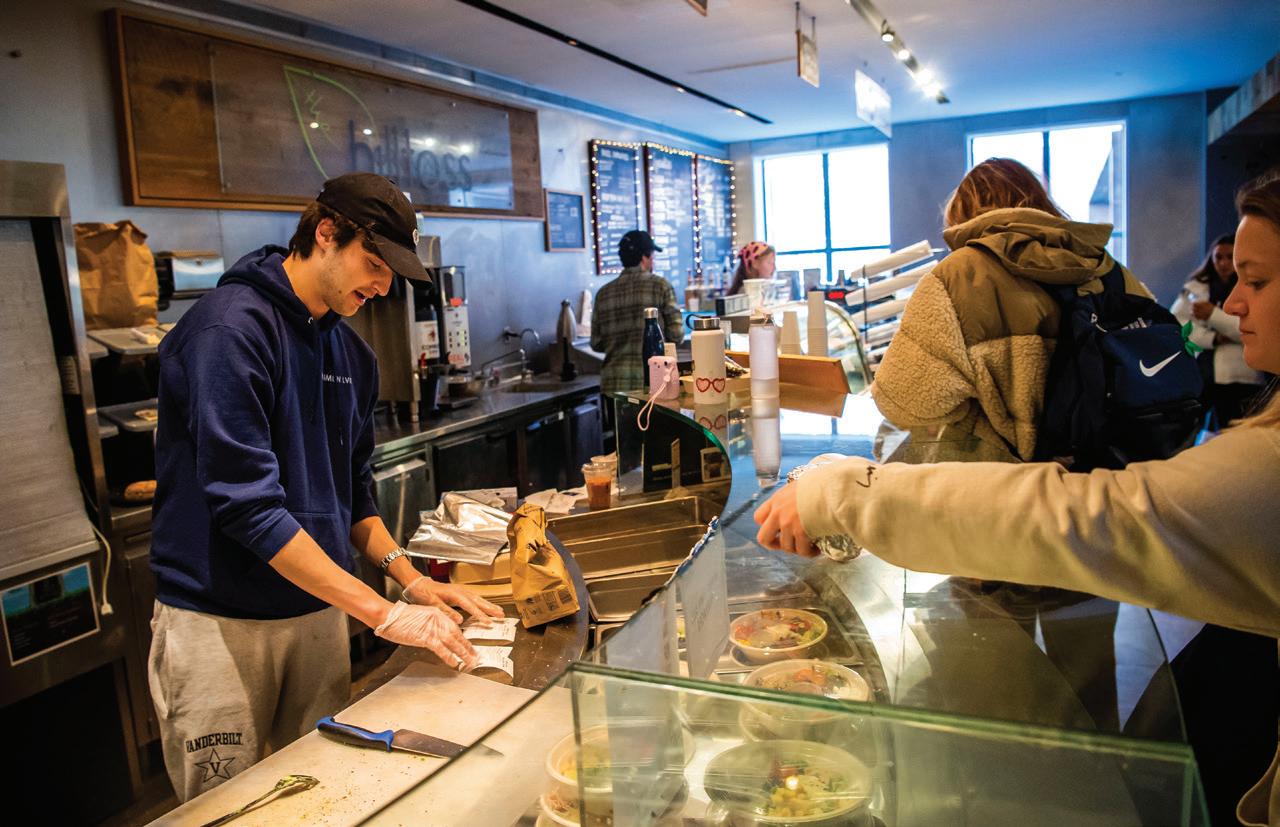
of reaching out for help.” Long after she left the Hilltop, she remained part of an email chain of former COOs offering support to their new counterparts. “It’s extraordinary to have a company of that size turn over its entire upper management every year, and its entire employee base every four years,” Duran says. “The Corp has flourished, and it’s done so by having a bunch of 20-year-olds at the helm.”
Confronting Challenges
Like any organization, no matter how successful, The Corp has not been immune from problems and growing pains. Shoplifting was an early issue, essentially forcing the closure of its earliest storefront, Diesmusbiedeplaz, a discount record store. A few enterprises failed to take off, such as a short-lived ice cream parlor called the Cone Zone in the 1980s. A 1981 article in The Washington Post [written by Kara Swisher (SFS’84), now a noted tech journalist] reported that an employee had stolen $14,000 from Vital Vittles the previous year. The student was expelled, and a portion of the money was recovered. Over the years, some students have perceived The Corp as exclusive, particularly because its size is limited by the number of employees it can hire. “As wages grew and The Corp’s prominence on campus rose, job applications began to increase, but the opportunity to hire more people didn’t,” says Bennie Smith. “One of the limiting factors was the commitment to serve people through low prices, so there wasn’t a lot of margin.” Management teams have taken steps to be more intentional in hiring and promotion, especially in recent years. This past fall, for the first time, The Corp expanded its voluntary demographic survey to include all applicants, rather than just interviewees.
“The goal of the survey was to serve as a foundation for future growth,” says Taotao Li (SFS’22), Corp vice president of people operations. “We can’t really create effective initiatives unless we know the quantifiable data.” In February, The Corp released a public report of its findings. Among the positive results: 29.2 percent of the hiring class identified as LGBTQIA+, greater than the university average. Other results pointed to a need for improvement. “A direct actionable that came about during our spring hiring cycle was mobilizing to increase outreach efforts with our affinity groups for Black and Latinx students, Shea and Incorporado,” Li says. She anticipates that the survey will become a standard practice each semester. The resilience that The Corp has gained over the years enabled the organization to navigate its most difficult period in its 50year history: the shutdown of its store operations during the COVID-19 pandemic. At the beginning of the pandemic in 2020, The Corp pivoted to providing storage services and online ordering. It provided more than $5,000 in emergency
1970s 1980s
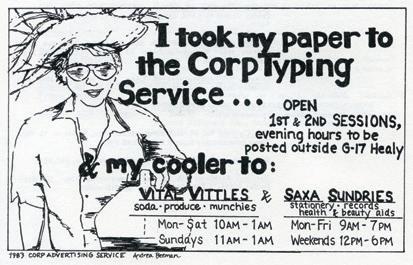
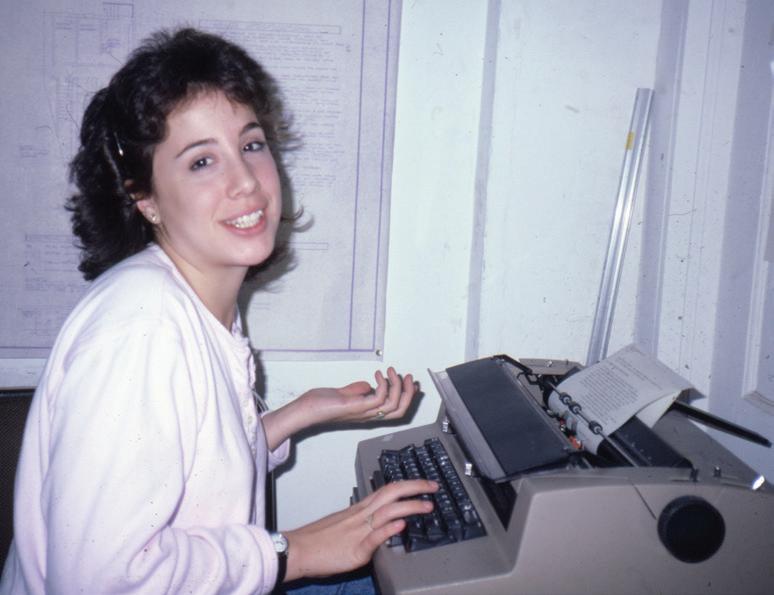
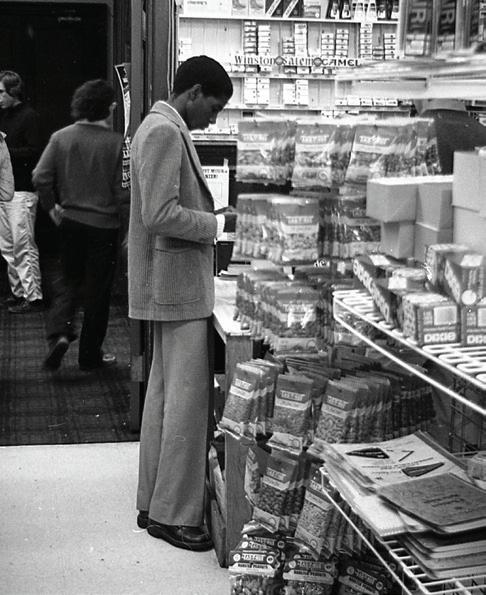
scholarship funds and initiated new partnerships with GU Mutual Aid and the Hoya Hub to address food insecurity. “In this last year, instead of pulling away from the university, we’ve really leaned in,” says Matt Davis. “They’ve been really helpful to us. And then on the flipside, we’ve had to show them that we are responsible enough to reopen, making sure all our employees are following the necessary public health guidance. So in that way I think we’ve built a lot of shared trust with the university.”
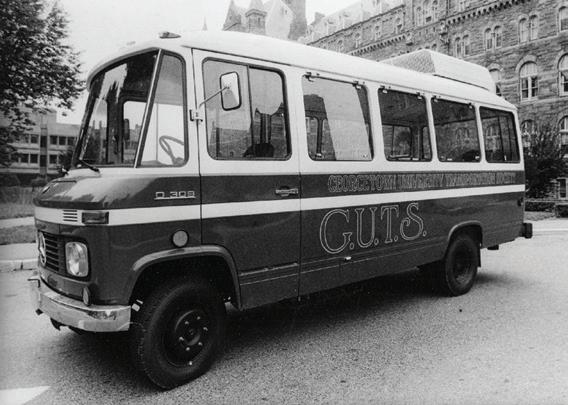
A Dynamic Future
All signs indicate that The Corp—having successfully navigated its first five decades—will continue to be a vital presence on campus 50 years in the future. For Davis, the key to future success is staying true to The Corp’s mission of students serving students while continuing to change with the times. “I have no idea what The Corp will look like in 50 years, but I hope it doesn’t look like it does right now,” he says. “We pride ourselves on being really dynamic and adapting to student needs. The mission and values of the company will stay the same, but I hope those will guide future leadership into evolving our services, evolving our engagement, evolving our philanthropy, to best serve Georgetown.” •
2020s 1980s
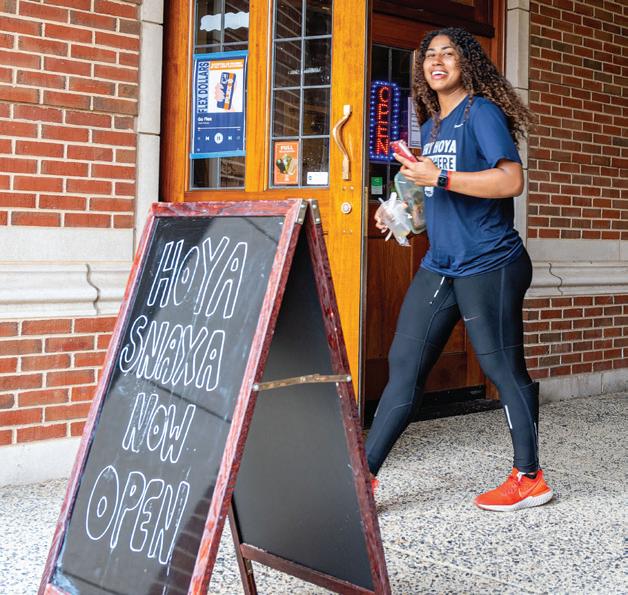
GUTS and Glory
Everyone on Georgetown’s campus is familiar with the GUTS shuttle buses that make their way up Wisconsin Avenue and around D.C. But it’s likely very few people are aware that GUTS began as an enterprise of The Corp. As with all Corp enterprises, GUTS was created to meet a need. “We had a terrible housing crisis at the time—very few upperclassmen could live on campus,” says Jack Leslie (SFS’76), head of the organization in the 1972-73 academic year. “A lot of kids were living in Arlington because it was cheaper.” With no Metro service into Georgetown, transportation was a big problem for many students. “We got a $106,000 loan from the university and—as strange as it sounds—purchased four Mercedes-Benz vans. Because they had much longer warranties and they were built so well, the operating costs in fact were less,” says Leslie. The Corp leadership viewed the service as a stopgap measure, and believed that the university would take over, as it did the following year. “It was called the Georgetown University Transportation Society, so the metropolitan bus authority couldn’t claim we were competing with them,” says Leslie. GUTS created a personal legacy as well—Dave Ralston (SFS’76), who ran the transportation service as a student, later became head of Reagan National Airport.
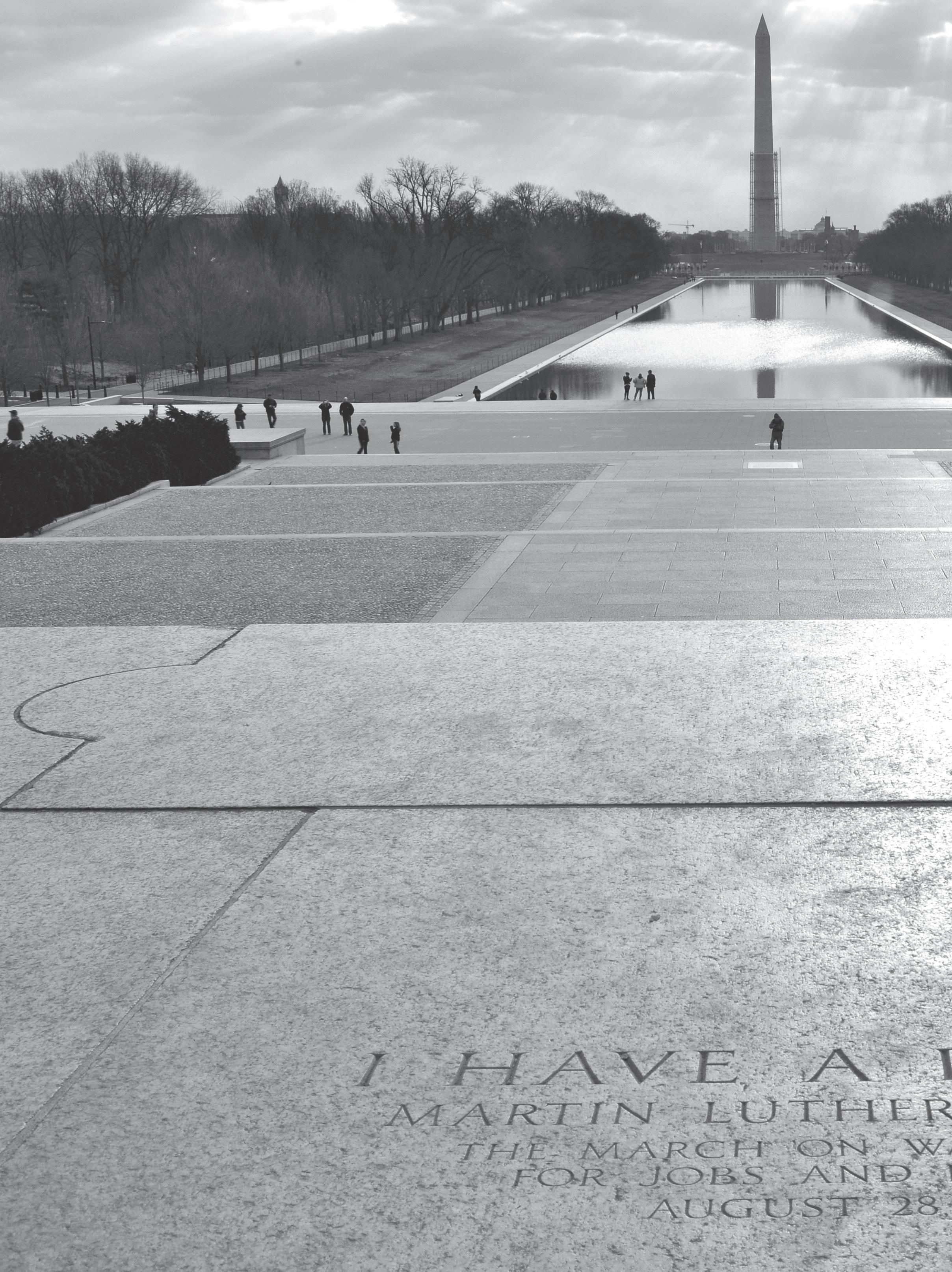
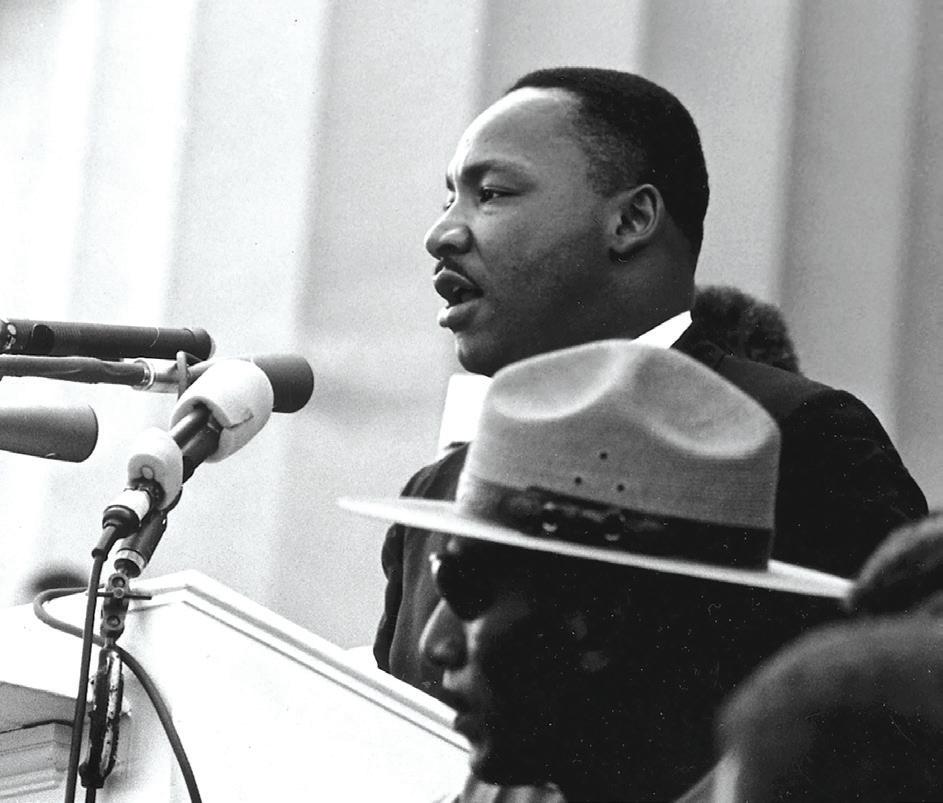
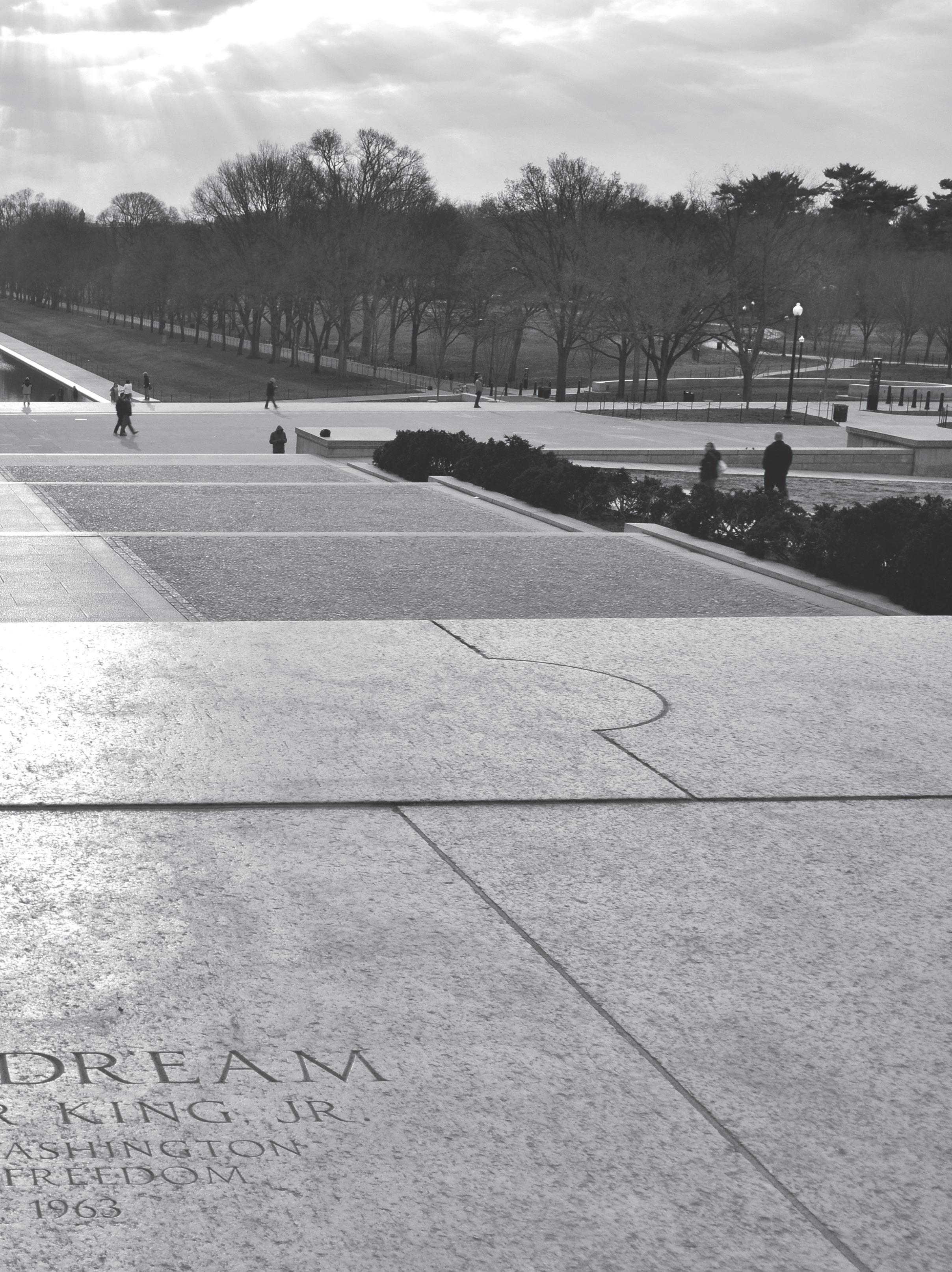
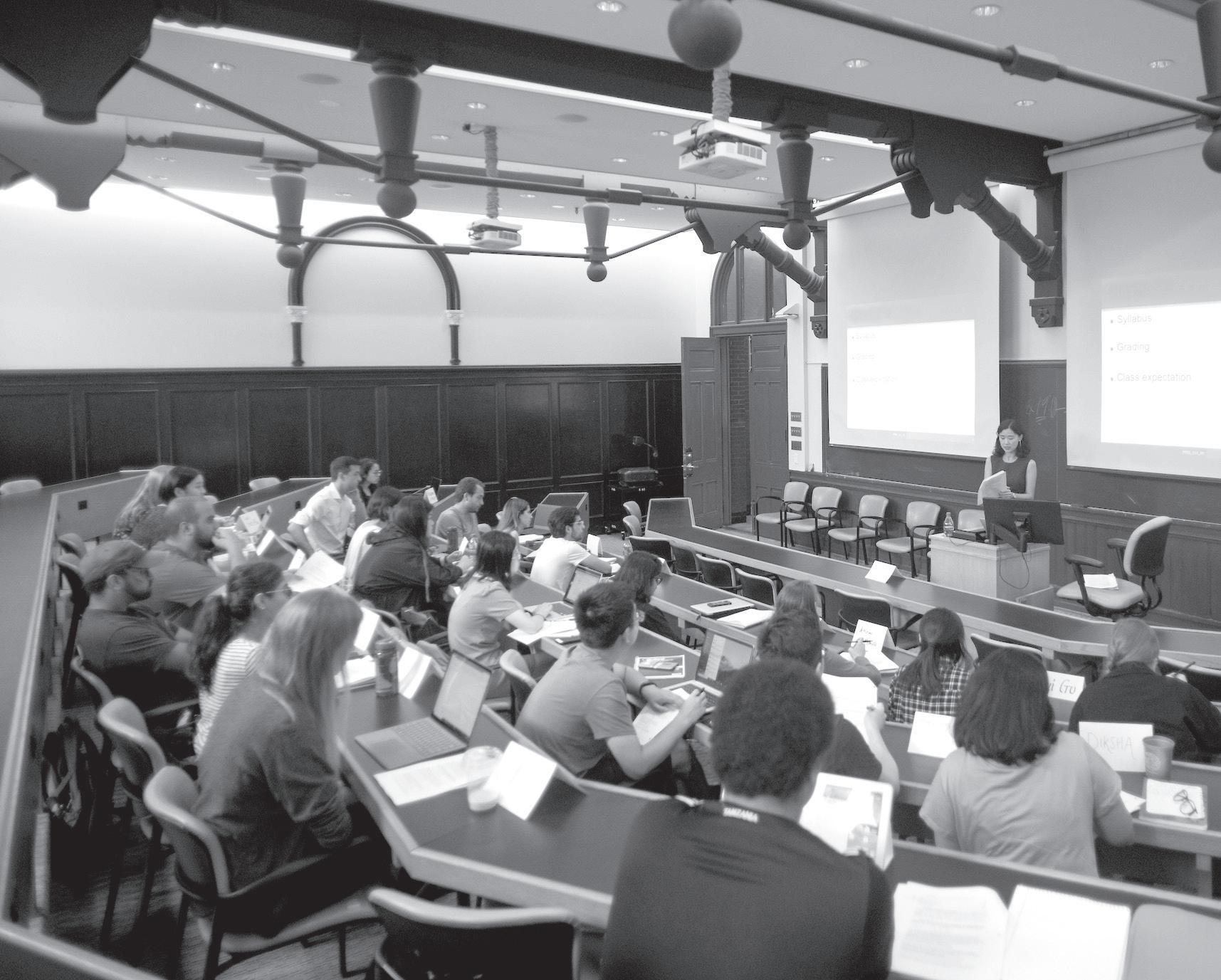
Few Americans would associate Martin Luther King Jr. with baseball. But Georgetown history professor Chandra Manning kicks off her course, Baseball and American Society, by having the class read and analyze one of the civil rights icon’s inspiring speeches.
“My approach is to use the text to introduce themes of the class,” says Manning, explaining that her course uses baseball as a framework to examine U.S. social, cultural, and political history during and after the Industrial Revolution.
“Dr. King’s speeches include issues such as equity and justice, violence and nonviolence. These themes also show up in the history of baseball when we talk about segregation in the major leagues and eventually breaking the color barrier.”
Manning, who joined Georgetown’s faculty in August 2005, was inspired to incorporate King speeches in all her spring semester classes—including Civil War and Emancipation, Biography and History, and What Is U.S. Citizenship?—after participating in the campus-wide Teach the
Speech teach-in. The annual event brings together faculty, staff, and students from the Main, Medical, Law, School of Continuing Studies, and Qatar campus communities to reflect on a selected King speech and share ideas about ways to integrate the text into the classroom. In Manning’s classes, King’s words inspire deep thinking about racial justice and also serve as a valuable tool for teaching students the technique of close reading, which involves identifying key phrases and word choices, examining structure, and looking for metaphors and imagery in historical documents. Manning uses the opportunity to talk about Georgetown’s Teach the Speech event and the value of a shared experience across disciplines. “My hope is that they come to understand that university education is a collective endeavor,” Manning says. “This effort can help students see their education as more than the sum of its parts—in other words, to see a whole to their education that transcends more than just four or five classes each semester or adding up the credits to graduate. It’s about entering into a life of inquiry.”
FACING RACISM AND INEQUALITY
The most recent Teach the Speech event, held virtually on Jan. 11, 2022, spotlighted King’s signature “I Have a Dream” speech, which he delivered on the steps of the Lincoln Memorial on Aug. 28, 1963. Keynote speakers were Veronica Williams (C’23), an American studies major with a minor in psychology; Virginia State Sen. Jennifer McClellan (D-Richmond), who has served for 15 years in the Virginia General Assembly; and Neonu Jewell (L’04), a Critical Race Theory Fellow at the African American Policy Forum. The event is sponsored by Georgetown’s Center for New Designs in Learning and Scholarship (CNDLS), the Center for Social Justice Research, Teaching, and Service (CSJ), the Doyle Engaging Difference Program, and the Division of Student Affairs. Teach the Speech is part of Georgetown President John J. DeGioia’s MLK Initiative: Let Freedom Ring! program that honors the enduring legacy of Dr. Martin Luther King Jr. through a series of events on campus and in the greater Washington, D.C., community. These activities—which include a service of remembrance and panel discussions on racial justice topics and the March on Washington—reflect the university’s Jesuit values of contemplation in action, care of the whole person, and being people for others. The university also partners each year with the John F. Kennedy Center for the Performing Arts to host the Let Freedom Ring Celebration, featuring special guest artists and the Let Freedom Ring Ensemble led by awardwinning composer/lyricist, producer, musical director, and cultural curator Nolan Williams Jr. During the event, President DeGioia presents Georgetown’s John Thompson Jr. Legacy of a Dream Award to an emerging leader from Washington, D.C. The inaugural Teach the Speech event, held in 2013, focused on King’s “Letter from a Birmingham Jail.” The first teach-in took place in 2017. Since its inception, Teach the Speech has brought dynamic speakers to campus, including Ibram X. Kendi, award-winning author of How to Be an Antiracist; environmental and climate justice activist Catherine Coleman Flowers; and the Rev. Brad Braxton, ordained Baptist minister and educator, and founder of the Open Church of Maryland. For Georgetown faculty, staff, and students who are unfamiliar with King’s speeches, Teach the Speech offers a chance for close examination of his ideals and vision. Though King died more than 50 years ago, his messages are still relevant today, says Patricia Grant, senior associate dean of the undergraduate program at the McDonough School of Business. “This is a wonderful opportunity for the whole campus community to look inward and think about the enduring lessons that Dr. King’s messages are giving us for today,” says Grant, who served as co-chair for a prior Let
Freedom Ring! initiative. “It’s paramount to make sure that his words and his legacy are an integrated feature of everything that we do at the university. That his messages reverberate and find residence within our hearts, spurring us to actions that promote an equitable society.”
As Georgetown continues the long-term process of understanding and responding to its role in the injustice of slavery—including the sale of 272 enslaved people in 1838 by the Maryland Province of Jesuits—the university-wide focus on King’s message is the right step toward healing, says Marilyn McMorrow, RSCJ, an associate teaching professor in the Department of Government.
“As a society, we have been trying to face structural racism as America’s original sin, and one in which Georgetown was complicit,” McMorrow says. “We’re enmeshed in structural racism, but it seems that in some parts of
American society, we’re finally trying to take the blinders off. What Georgetown is doing with Teach the Speech is an important part of that conversation.”
TEACHING THE SPEECH
Just as Manning incorporates the teach-in’s selected King speech into her history classroom, faculty across a range of disciplines have found creative ways to teach King’s messages. For Barbara Leary, omitting King’s speeches in her graduate-level speechwriting course “would be tantamount to instructional malpractice,” she says. By helping students appreciate the “soaring rhetoric and passionate delivery and effective repetition of the phrase, ‘I have a dream,’” Leary touches on the most important aspect of speechwriting: connecting with the audience. One of her assignments requires students to write a speech that would be delivered to an imaginary, hostile audience—one with
“wildly diverging views” from the speaker. “This effort can help students see their education as more than the sum of its parts—in other words, to see a whole to their education that transcends more than just four or five classes each semester or adding up the credits to graduate. It’s about entering into a life of inquiry.” —CHANDRA MANNING
“This project illustrates an important technique in speech writing: getting the audience to really imagine what that better world might look like if the solution the speaker is proposing were to come to pass,” says Leary, an adjunct faculty member in the Public Relations & Corporate Communications master’s degree program. “Dr. King was a master of the art and craft of speaking, with an electric delivery, and that way he had of just seizing an audience and bringing them in with the message of hope and inspiration. It’s rare to see that.”
J.R. Osborn, associate professor in the Communication, Culture, and Technology master’s program, uses insights gleaned from Teach the Speech both to meet course objectives and to facilitate a greater understanding among students of King’s impact in the United States and beyond. In his Graphic Design Studies class, for example, graduate students’ key aim is to develop skills for the critical analysis of graphic design, including the ability to visually convey a client’s desired messages. Osborn has students design and produce an item incorporating the entire speech. Additionally, they must include reflections on King’s legacy and an essay describing the rationale for their design choices. The results have been impressive, Osborn says. Students have created a wide range of products, from brochures, posters, and booklets to T-shirts, album covers, English language teaching guides, and a museum shop gift bag. “Students have to read the speech and decide the best way to present it, and the range of creative responses has just blown me away,” says Osborn. “I frame the assignment as a lesson in professional design practice, but I also talk to the students about Georgetown’s commitment to encouraging dialogue on campus about Dr. King’s legacy and social justice.” Osborn says the challenge to incorporate King’s ideas across curricula also has stretched his skills as a teacher and scholar.
“The value of the teach-in is that it helps those of us who are teaching this material to get a broader sense of the context of the speech and its importance,” Osborn says. “In academia there’s often hesitation to teach about things that are outside of our expertise. The teach-in challenges us as professors to say, ‘I might not be a scholar of Martin Luther King Jr., but these discussions are important.’ I’m willing to put my time into learning about Dr. King and sharing that with my students. And the teach-in gives faculty a chance to discuss ideas for assignments and approaches to teaching this material. That gives everyone a sense of how the speech is being used across campus and how King can be relevant across disciplines.” Participants in the Teach the Speech teach-in sessions often gain new insights and perspectives on King’s message. Laura Bishop describes Teach the Speech as “uplifting and refreshing” for faculty. “The experience really reminds us of both the purpose of teaching and the purpose of working together on important issues like justice,” says Bishop, associate teaching professor and academic program director for the Kennedy Institute of Ethics.
Bishop still feels inspired thinking back on the 2019 event, which focused on a speech entitled “Remaining Awake Through a Great Revolution,” which King delivered at the Washington National Cathedral on March 31, 1968, just days before he was assassinated. The content was particularly relevant for her course Climate Change and Global Justice, and she assigned the speech as reading material for her students.
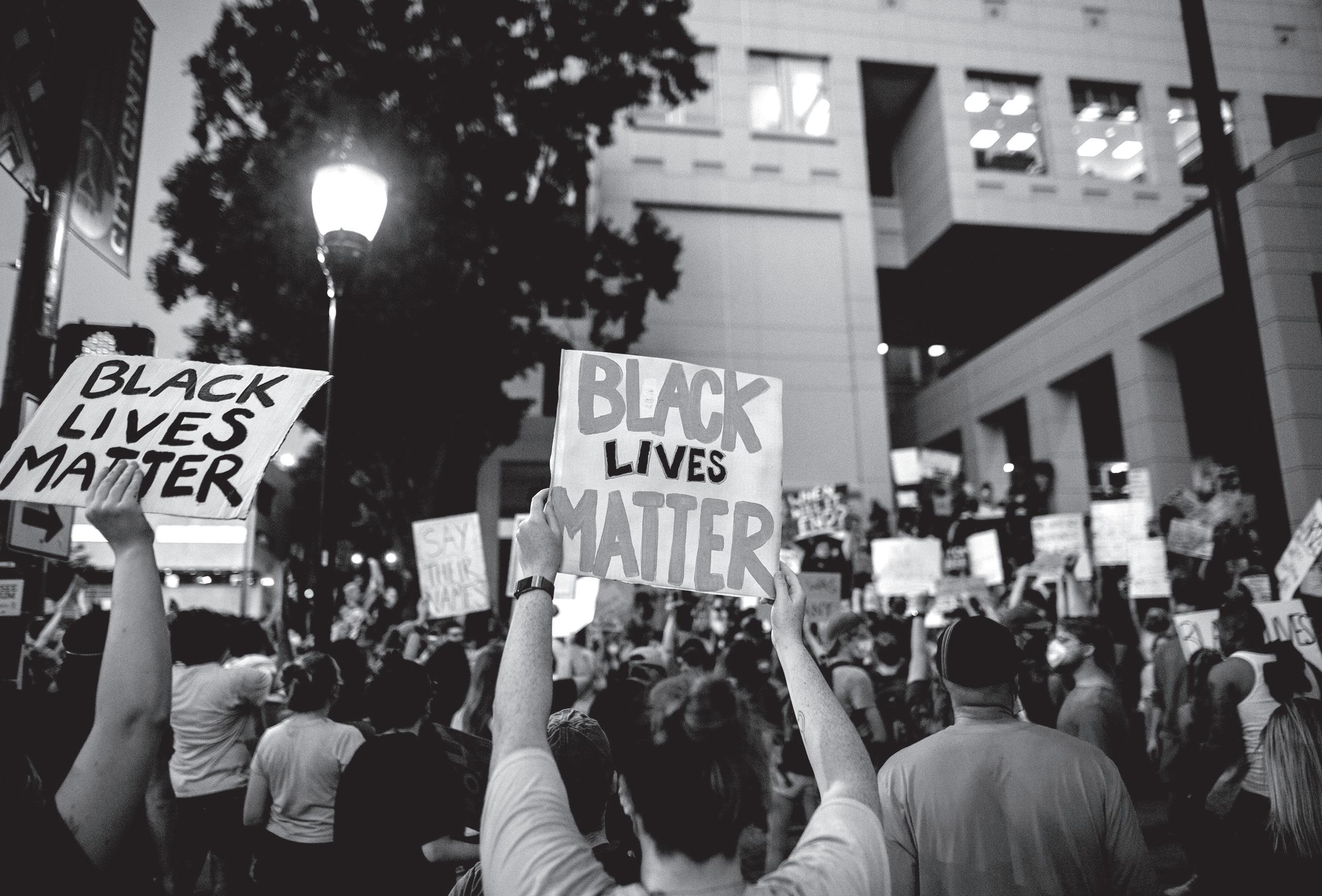
“I was struck by how the words resonated with the focus of our course and classroom discussions on climate change and global justice,” Bishop says. “Namely, that the impact of our actions and choices would affect other human beings and non-humans around the world both now and into the future, in very deep ways. Dr. King spoke about how the ‘destiny of the United States is tied up with the destiny of India and every other nation’ of the world. That all of life is interrelated, ‘in an inescapable network of mutuality.’ He was speaking about themes and concerns that are some of the most fundamental in human life.”
Jamie Kralovec, associate director for mission integration at Georgetown University’s School of Continuing Studies, says Teach the Speech offers the campus community “an incredible opportunity to animate our mission of community-engaged learning in service of equity, justice, and the common good.” As a Christian, King drew from his religious heritage to promote the work of social justice and equity. Kralovec says reflecting on King’s words offers new inspiration and hope for today’s challenges. “Dr. King’s speech is actually a challenging and demanding call, issued then but still reverberating today, to work for justice in a multiracial democracy by directly addressing the roots and effects of structural racism,” Kralovec wrote in a recent blog on Mission in Motion. “As the United States continues to experience social, cultural, and political polarization around persisting racial injustices in all facets of society, MLK’s iconic 1963 speech presents a valuable opportunity to renew the discussion in 2022 and re-commit to tangible actions at Georgetown.”
RECLAIMING KING’S DREAM
Teach the Speech typically focuses on a lesser-known King speech to broaden participants’ knowledge of his work. But the planning committee was inspired this year to select “I Have a Dream” after reading Kendi’s Oct. 14, 2021, article in The Atlantic decrying the “second assassination of Martin Luther King Jr.” The piece condemns exploitation of the iconic speech by politicians and pundits who take King’s words out of context to justify denouncing critical race theory and efforts to facilitate a national dialogue on racism. “It may seem cliché or obvious to pick this particular text, but we wanted to name that concerted effort to weaponize Dr. King’s words and misrepresent his vision,” says Andria Wisler, CSJ executive director. “We also wanted to lift up critical race theory because it’s being pummeled in the national conversation. In choosing ‘I Have a Dream,’ we invited the Georgetown community to re-engage with King from that place where most of us first learned of him.” In her reflections during the recent Teach the Speech event, Williams shared that although she was exposed to King’s speeches during her formative years—primarily at church— she doesn’t remember in-depth lessons about Black history in K-12 classes. She challenged her Zoom audience to educate themselves about the Black experience in America and to take bold steps to fight racism. “Black people and Black history are too often seen as onedimensional, so much so that it’s treated like we don’t have history or culture,” says Williams, producer of the podcast “Tea With V,” a member of the University’s inaugural cohort of Campus Ministry’s Black Interfaith Fellowship, and communications and outreach lead for ESCAPE, Georgetown’s first-year retreat program. “Prominent Black figures, even those as massive as Dr. King, are cast as background characters in the story of America … Dr. King encouraged us all to dare to dream and to fight against the forces and systems that want us to stay complacent.” Reflecting on the core message of King’s 1963 address, Williams says, “With radical hope for the future and a never-ending fire and desire for freedom and justice in his heart, King paints a picture of an America where the American dream is for everybody.” Despite changes to American society since the 1960s, there remain a number of challenges to realizing a truly equitable country. According to Williams, “Progress has been made in the fight for racial justice, but as we reflect nearly 60 years after Dr. King stated ‘the Negro still is not free,’ in 2022 Black people are still not free from racism and discrimination in America.”
Continued activism in the vein of Dr. King is where Williams finds hope for the future of racial justice. “Dr. King having a dream and seeing it progress to becoming a reality inspires me to continue to dream, as there is power in dreaming,” says Williams. “To dream is to make sense of the past, take ownership of the future, and inspire action in the present.” • Henry D. Brill contributed to this article.
Celebrating 70 years of women’s sports at Georgetown
Special events honor the contributions of female athletes
BY KATE COLWELL AND CAMILLE SCARBOROUGH I DESIGN BY WANDA FELSENHARDT
In 1952, Georgetown students at the Nursing School established the Women’s Athletic Association, allowing women to participate in intramural sports. The association expanded in 1963 to allow for university-wide participation, a decade before Title IX was passed. For 70 years, Hoya women have broken countless barriers and represented the university worldwide. The Georgetown University Department of Intercollegiate Athletics is celebrating its female athletes with special stories and events throughout 2022. “From field hockey in 1952 through the addition of women’s squash in the current school year, our 14 women’s teams engage female studentathletes in the rigor and challenge of intercollegiate sports,” says Lee Reed, the Francis X. Rienzo director of intercollegiate athletics. •
1955 1969
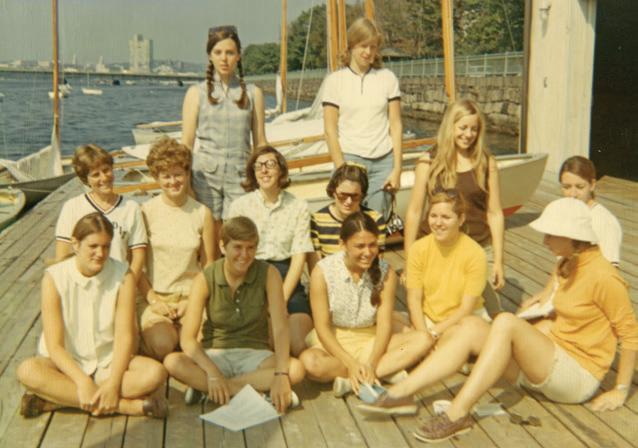
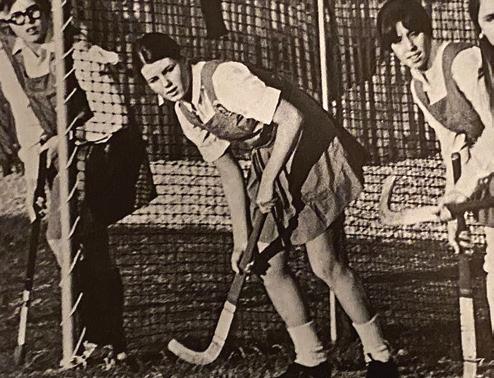
1970 1987
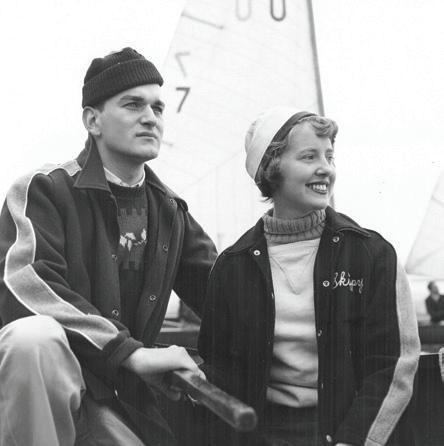
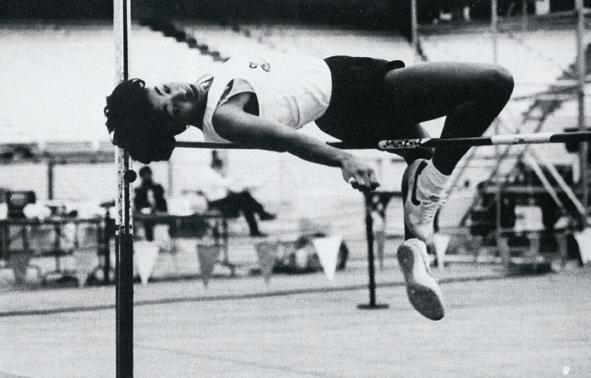
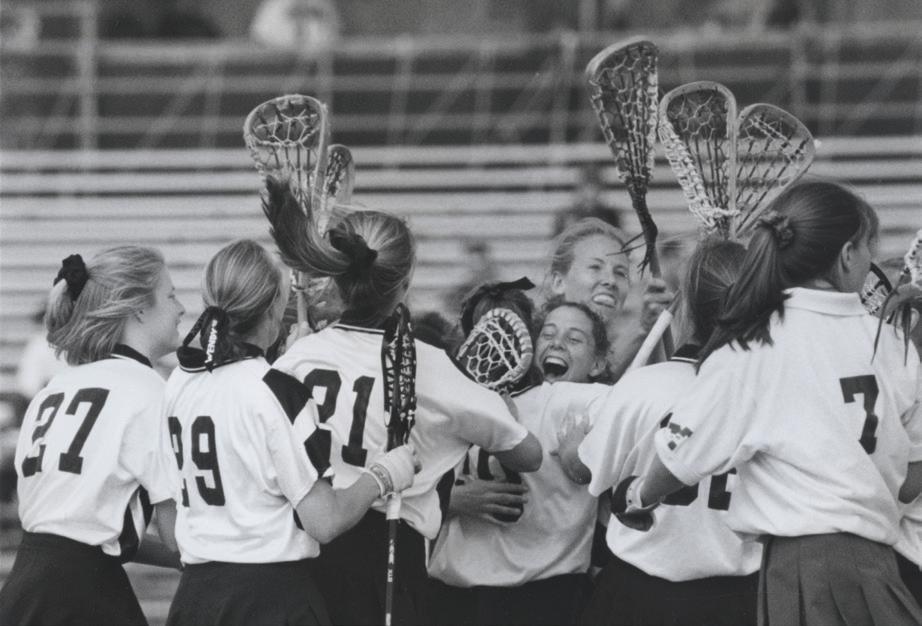
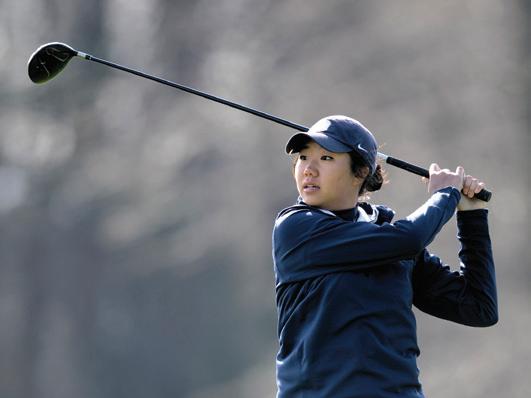
2010
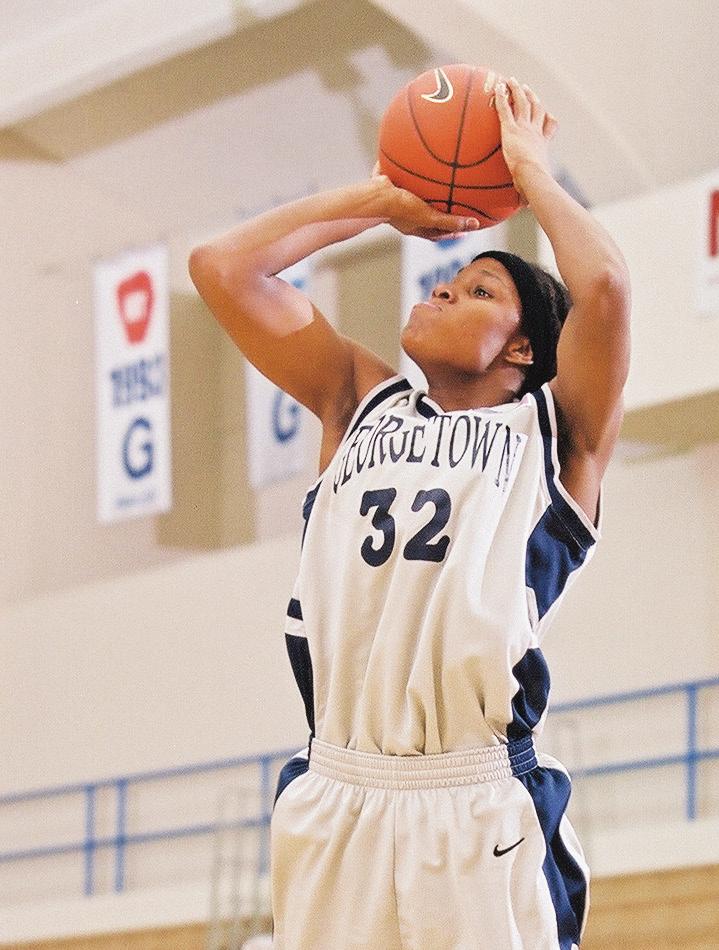
2004
1955: Kathleen D. “Skippy” White (NHS’57) becomes the first Georgetown woman to win a varsity letter; 1969: Women’s sailing poses at Intercollegiate Nationals; 1970: Women’s field hockey represents the Blue and Gray; 1987: Women’s track and field sets a high bar; 1995: Women’s lacrosse celebrates a key victory; 2004: Rebekkah Brunson (C’04) is the first women’s basketball player in Georgetown history to grab more than 1,000 rebounds; 2010: Golfer Eunae Jo (B’12) plays in all 10 tournaments each year at Georgetown; 2020: Georgetown wins the BIG EAST Women’s Soccer Championship in overtime. Photos: Georgetown Athletics
